October 27, 2024
| Valerie Hayes
| Feature Articles, Health & Wellness, My Story, Thoughts & Ideas, Valerie Hayes, View All Articles & Photos
Opiates are dangerous. They have been used for thousands of years, and have a legitimate role in short term pain management, and palliative care. But they are also highly addictive, and have claimed millions of lives. In fact, entire civilizations have collapsed as a result of widespread opiate use.
Many people believe in the concept of safe supply, which means people use prescribed government sanctioned opiates from legitimate pharmacies, as opposed to risking the opiates on the streets, without knowing for sure what is in them. Millions of pills that look exactly like OxyContin, Percocet, or Xanax, are laced with lethal doses of fentanyl.
Fentanyl is a synthetic opiate made in clandestine labs in Mexico, Columbia, China, and more recently, one was located in BC, Canada where police discovered 25 kg of pure fentanyl. That is enough fentanyl to kill several thousand people.
In addition to lacing pills, and other street drugs with fentanyl, it has also become a risk factor for cannabis to be laced with fentanyl. This dramatically increases the risk for all people, including those who use cannabis for medical reasons. It places millions of young people at even greater risk.
Did legalization really increase the safety of cannabis? Prior to legalization, there was no such thing as cannabis overdose. But now with very high concentrations of THC in candies, lollipops, shatter, and other doctored cannabis products, it is no longer a matter of mild-mannered 1970’s home grown weed.
Cannabis no longer resembles what it used to be. In recent years, children, dogs, and seniors have suffered from cannabis overdoses. The unnaturally high, and potentially toxic amounts of THC can also place vulnerable people at risk for psychosis, especially if combined with alcohol or other drugs. With the potential introduction of fentanyl into certain cannabis products, it means the only safe way to use it is to grow it yourself.
No class of opiates are entirely safe, because even prescription opiates can lead to fatal overdoses, if taken too frequently, or in conjunction with drugs that potentiate their effects. Plus when people become addicted to prescription opiates, it is not long before they will turn to street drugs, to seek a stronger high, or when they can no longer get prescriptions. Once addicted, better judgement goes out the window. In fact – it flies off a mountain top, until the poor person crashes on the rocks below.
Fentanyl is fifty times stronger than heroin, and a hundred times stronger than morphine. The amount it takes to kill a person is less than the size of a pencil tip.
Many people advocate the use of fentanyl test strips, which may help detect fentanyl, but they are not always accurate. The test strip might be used on an area of the drug without a concentration of fentanyl, and miss the area where it is located. Fentanyl in fake prescription tablets, is not likely to be evenly distributed.
Opiates are highly addictive. Although the rate at which people can become addicted varies, within a week to two weeks of daily use, most people will have developed a physiological addiction.
As a person gets deeper into the addiction, they are seeking the drug to prevent getting dope sick. Many people describe withdrawal as being a tortuous experience. Detoxing can be dangerous if not done in a supervised medical setting. A person can become severely dehydrated from nausea, vomiting and diarrhea. They suffer greatly, and unless they are managed properly, and with empathy, in order to help them through it, they will desperately seek a fix.
To top it off, even for those who do go through detox and treatment, the relapse rate is very high. Most of the treatment facilities are thirty to ninety days. As an adjunct they may also provide sober living, AA classes, support groups, and life skills. Most have some sort of program to follow.
In many cases, the facility will prescribe drugs to ease the detox, such as benzodiazepines, Suboxone, or methadone. If a person is released while still dependent on these other drugs, they may, or may not be able to function well. Some people remain stable on methadone. Ideally a person will get free of all addictive drugs, and become drug free.
In addition to having the desire to quit, combined with a successful detox, the addict must have a very good plan in place, in order to succeed long term. They cannot succeed if they return to friends who are using, family members who are using, a party lifestyle, old habits, or boredom.
They will need to gradually deal with the underlying causes of the addiction, and find ways to develop resilience to protect their emotional and mental health. Often there is a co-dependency within families, which makes it very difficult for the addict to separate themselves from what is toxic, in order to maintain their well being, and progress.
Sometimes families mean well, but the ingrained patterns that led to the addictive behaviours can be filled with denial. A parent who drinks a lot might be judgemental toward a teenager who uses crystal meth. But to the teenager, they see it as hypocrisy. A mother who takes pain pills, or tranquilizers prescribed by a doctor, might be outraged at her fourteen year old smoking marijuana. Yet all of those things are part of the addictive dynamic.
They need to set up a personal care plan carefully tailored to both their strengths, and their weaknesses. They have to be very conscious of who they hang around with. To succeed, they have to abandon the relationships, lifestyles, and party places that were part of the earlier lifestyle.
They have to find relationships, and activities that change the old patterns, and keep them occupied. Many addicts quickly go from being an addict to being a therapist, which I do not think is a good idea, unless they have had plenty of time to get stable in every way.
It is helpful for people to support each other, and share success stories etc. Sometimes I wonder if addictive personalities can help cure other addictive personalities. I think they have empathy and experience, to be able to relate to what another person is going through, but they might not have in depth insight, or intrinsic stability for a very long time.
Many people who really want to help others, still need to sort out how they are going to help themselves. Getting free of the addiction, is only a portion of the battle. It takes years to figure out the pitfalls and cause of the addiction, and it is different for each person. Often it is tied to complex family dynamics.
If there is complex PTSD to overcome, especially from childhood trauma, a certain amount of the trauma is hardwired into the memory, and actual central nervous system. There are triggers that create an avalanche of cortisol, and other stress hormones. Since those are autonomic nervous system reactions, the person has no control over them.
Even if a person has managed to overcome complex PTSD from childhood trauma for the most part, it can still crop up and cause extreme distress years later. If there are enough stressors, that go on for a period of time, especially things like loud noises, sudden banging, yelling, screaming and cursing – those are all precursors to memories of impending violence.
With complex PTSD arousal, every system of the body, thought processes, adrenalin, cortisol etc. kicks in, to create an internal replica of the fear and helplessness of childhood trauma. No one likes to be subjected to screaming and cursing for prolonged periods, but for people who are triggered by someone else’s rage, such exposure has to be avoided at all costs. There is a cumulative effect, and the tension cannot be relieved until the verbal raging, cursing and threats are stopped. It is a re-creation of familiar events.
For the recovering addict, it also takes time to rewire the neurochemistry, and brain gut health, so a nutritious whole food diet is essential. Exercise, purpose, goal setting, dopamine restoration, improved self esteem, and meaningful work are the building blocks they need for long term success. They have to have a strong desire to succeed.
The thing about overcoming addiction, is that life gets easier in some ways, but it does not stay easy. There can still be plenty of adversity, so the challenge is to avoid using any substance again, no matter what happens.
People often relapse over a breakup, job loss, major conflict, or death in the family. Regardless of what happens, the commitment to stay clean and sober must prevail. Circumstances cannot dictate sobriety. The locus of control must come from within.
Probably one of the biggest pitfalls is that of substitute addictions. An addict might switch from opiates to prescribed benzodiazepines, which are also highly addictive, and difficult to get free of. They can be equally as destructive, and the detox actually takes longer. People have to taper by minute amounts, sometimes over a period of a year or two.
All people should realize that every type of psychoactive drug can, and will strike back and haunt them if they take the drug for any length of time. This includes antipsychotics, which also interfere with dopamine receptors and mood, SSRI, or antidepressants, and all sleeping pills.
Steroids are also dangerous if taken over time. They can wreak havoc with every system of the body, including the emotions, and self control. People on steroids can go into uncontrolled violent rages. If they need surgery or get ill, steroids can also mask the signs of infection.
NSAIDs or non-steroid anti-inflammatory drugs are not psychoactive, or addictive, but they too must be taken with caution, especially for older people. They can cause stroke, stomach problems, heart problems, kidney problems and liver problems.
People who are trying to overcome addictions might switch to over eating, sugar cravings, or drinking alcohol. They might still believe they are doing okay, and can manage the addiction. Even gambling, exercise, work, shopping, and sex can become substitute addictions.
Some people say they never get free of the desire to use again. Others do not feel the compulsion to use again at all. For them, the negatives are a greater deterrent than the positives. There is no high without a worse, and corresponding low.
They know they will be right back on that self destructive roller coaster if they use again. There comes a point, after detox and recovery, where using again is a choice. There may be some compulsion prompting them, but it is not so strong that it cannot be controlled, or diverted to a healthier alternative.
They have to be vigilant, and know their own weaknesses. For some people, a twelve step program works. I tend to believe that a person has to redesign the patterns of their life, in every way. All of the old habits must be broken, including patterns of thinking, and emotional management.
They must learn to avoid catastrophic reactions to set backs, break ups, financial distress, and most of all, if they have an accident, or must have surgery – how they will manage the short term use of opiates, without relapsing.
When thinking about the high failure rate of many treatment programs, I thought of creating an outline that parallels the book by John Bunyan called “The Pilgrim’s Progress”. The essence of the story is an allegorical dream sequence.
This concept would probably not be accepted in the secular world, but I believe we cannot overlook the fact we are spiritual beings. The Pilgrims Progress depicts the journey of a Christian, and shows just how much has to be overcome in the entire odyssey of life.
I found it interesting to note, that he did not come across a character called Grief in his travels. But grief is something we will all encounter, and is often one of the most devastating emotions of all human experiences.
In the story, the main character Christian, is anxious, ashamed, and has a massive burden on his back. The burden is so heavy, he fears it will cause him to sink into hell.
In an attempt to get free of the shame and burden, he decides to leave the City of Destruction, which is filled with evil and sin. He is advised by Evangelist to go to the Wicket Gate, and head for the Celestial City. He cannot see the gate, but is told to look for the shining light.
Initially, Christian sets off with a companion named Pliable, and before long, they fall into the Slough of Despond. A character named Obstinate has followed them, and tries to convince them to go back. With much difficulty, Pliable manages to crawl out of the pond, but is thoroughly discouraged, and follows Obstinate’s advice, and heads back to the City of Destruction.
Christian, due to the heavy burden on his back, sinks in the slough, and cannot get himself out. A man called Help comes and pulls him out. He carries on his journey, and soon comes across Mr. Worldly Wise Man, and gets some secular advice. The worldly wise man instructs him to seek the advice of Mr. Legality, and his son Civility in the village of Morality.
He heads to the mountain where they live, but it towers over him, has fire shooting out of it, and threatens to crush him.
Evangelist intervenes, and tells him to forget it, they are frauds. He advises Christian to stick to the path taking him to the Wicket Gate. To get to the straight and narrow, he must get on The King’s Highway, but then he encounters Beelzebub, who shoots at him with arrows.
A character named Goodwill saves him from Beelzebub, and tells him about Jesus. Christian tells Goodwill about the heavy burden he has been carrying. Goodwill directs him to the place of Deliverance.
From there, Christian makes his way to the House of Interpreters, who show him many things, to signify a Christian life, and the importance of faith. Finally Christian reaches the place of Deliverance. At last, the straps holding his heavy pack break and fall away into an open tomb, or sepulchre.
Then three angels visit him, to greet him, and give him peace. They provide new garments, and a scroll, which is a passport to the Celestial City.
Encouraged by his new found freedom, and his assurance of getting to his destination, he encounters more struggles. As he carries on, he comes across Simple, Sloth, and Presumption. Christian tries to talk to them, and help them, but they will have nothing to do with him.
Then he gets to the Hill of Difficulty, and meets two well dressed false Christians named Hypocrisy, and Formality. They were haughty, and sure of themselves, and were certain they knew the way to go. Before long, both of them end up perishing in two dangerous bypasses called Danger and Destruction.
Christian, weary from his travels, falls asleep in the arbour above the hill, and later, realizes he has lost his passport into the Celestial City, so he must retrace his steps to find it.
He comes across Timorous, and Mistrust who tell him about a den of lions on the way to Palace Beautiful. He manages to avoid the lions, and is then told by the Watchful Porter that they are chained, and are there to test his faith.
When he gets to the top of the Hill of Difficulty, he stays at the place called Palace Beautiful for three days. It is a place built by God for pilgrims on their journey, in order to replenish and refresh them. While there, he is told to put on the full armour of God (Ephesians 6: 11-18) to get him through the upcoming battle.
He ends up travelling into the Valley of Humiliation, and finds himself face to face with the great dragon Apollyon, who he battles for a half a day. Finally he is able to stab him with his two edged sword from the armour of God he put on earlier. The dragon flees.
Before long it is nightfall, and Christian ends up in the Valley of The Shadow of Death, where it is dark, terrifying and full of demons. He hears a character named Faithful read the twenty third Psalm: “Yea though I walk through the valley of the shadow of death, I will fear no evil: for thou art with me; thy rod and thy staff they comfort me.”
When he leaves the valley of the shadow of death, much to his relief, the sun is shining. He meets Faithful who he knows from the former City of Destruction. Together the two of them go to a place called Vanity Fair. It is designed by Beelzebub, and is filled with lust, and all manner of temptations at the Fair. Both Faithful and Christian have disdain for such things.
Faithful is put on trial there and is executed, which transports him immediately to the Celestial City as a martyr. Christian then finds another companion called Hopeful. They end up facing much more adversity as they continue on their travels.
They try to take a shortcut, but end up being captured by Giant Despair, and his wife Diffidence, known for their cruelty and torture. They are then locked in the Doubting Castle where they are beaten and starved.
The Giant and his cruel wife want them to commit suicide. They are so beaten down, they are tempted to do so. Finally, Christian realizes he has a key called Promise, which fits into the keyholes of the locked dungeon. So they manage to escape.
As they get closer to their destination, on the Delectable Mountain, they meet the Good Shepherds. Finally through the Eyeglass of Perspective, they can look through it, and see the Celestial City.
Even though they are getting closer, they are warned not to be deceived. They meet the Flatterer, and follow him, being led astray until they see an angel who they think is the shining one, but they are deceived, and soon get stuck in a snare.
A true angel frees them from the snare, and puts them back on course with a stern warning. They then meet Atheist who mocks them, and tells them Heaven and God do not exist. They ignore him, and carry on.
They pass by a character called Wanton Professor who is chained by seven demons. There is a ferocity of vile projections, and then the Professor takes a shortcut to the Lake of Fire.
Next they meet a man named Ignorance, who is convinced he will be taken to the Celestial City because of his many good deeds, instead of as a gift, by the grace of God.
Christian and Hopeful try to convince Ignorance that he cannot get to the Celestial City on his own merit. Nevertheless, he insists on going his own way, and takes the perilous ferry of Vain Hope over The River of Death.
When Ignorance finally makes it to the Celestial City, he has no passport, and is denied entrance. He had not travelled the King’s Highway in order to get there. The angels took him away to hell.
Christian and Hopeful, almost there, still had to go through the Enchanted Ground, a place which made them very tired and sleepy, but they knew if they fell asleep there, they would never wake up.
They too, have to cross the River of Death, and they finally make it to the Celestial City, where they are welcomed, and allowed in.
Even though this is a Christian based allegorical story written in the 1600’s, it does give an indication of the struggles, difficulties, pitfalls, snares, and battles we all have to endure.
Too many times, we think, or expect things to be easy, or to go through life without falling into the pit of destruction. But on many levels, the journey as described in the Pilgrims Progress, is closer to what it is really like, especially for the addict.
Christian’s final companion on his journey to the Celestial City was Hopeful. I think John Bunyan was quite right to make Hopeful the strongest ally, and friend to help him reach his destination.
Copyright Valerie J. Hayes and Quiet West (2024). Unauthorized use and/or duplication of this material without express and written permission from this blog’s author/owner is strictly prohibited. Excerpts and links may be used, provided that full and clear credit is given to Valerie J. Hayes and Quiet West with appropriate and specific direction to the original content.
July 11, 2024
| Valerie Hayes
| Feature Articles, Health & Wellness, My Story, Thoughts & Ideas, Valerie Hayes, View All Articles & Photos
For those who take issue with speaking ill of the dead – don’t worry, I realized this author was over rated, long before she was dead. Long before I delved into the details of her rather unsavoury background, and family betrayal.
Bear with me as I switch from past to present tense. I know her writing still exists, therefore it is. But she no longer exists, and for me, her writing is in past tense, therefore it was.
I will never pick it up again, except to do research, and try to expand our literary assessments, as opposed to being told what is good, when it is not good. The issue of addressing child sexual abuse, preventing it, and validating the testimonies of the victims, is far more important than the legacy of a deceased author. I never could understand why Alice Munro was promoted to such an extent.
For years, I would read the gushing reviews, and then try to read something she wrote. I would think to myself, this sounds like a trashy Harlequin romance or worse. What on earth do people see in this? In my opinion the sexism, and stereotyping of girls and women, was superficial, trite, and at times appalling.
I have made a point of reading famous authors to include Hemingway, Steinbeck, Dickens, Virginia Woolf, Emily Dickinson, Jean Paul Sartre, F. Scott Fitzgerald, Tolstoy, and Voltaire as some examples. I even delved into Schopenhauer at one point, but struggled with it due to the oppressive pessimism.
But nevertheless, I can understand why many authors are notable, and deserving of accolades. Even so, all art is subjective, so like beauty, the merit is in the eye of the beholder.
Alice Munro never once struck me as being a genius writer. Not even close. Her material was fictional, and narrowly limited in range and scope. It was repetitious ad nauseam, yet so many emanated how she was realistically showing the depth of the human condition. Hardly. If so, they were drawing from a shallow well.
Now that her daughter has come forward, it makes so much more sense to me why I found her work to be stomach turning. Reading between the lines, there was definitely something grotesque beneath the surface of all the slick linguistics.
The Globe & Mail wrote an article about her fight with censorship in the seventies. The article goes on to say that in 1976, the principal of Kenner Collegiate Vocational Institute in Peterborough, Ontario brought forth concerns about Alice Munro’s “The Lives Of Girls And Women” being taught in schools.
He had overheard a student claim it was pornographic. The central issue is that the story explicitly describes a man masturbating in front of a young girl.
In hindsight as we review the rearing of the ugly head of child molestation, and pornography in schools, we now know that Alice Munro’s husband molested her nine year old daughter, during the same time frame Alice Munro so vehemently defended her tacky material.
Her daughter was molested in the 1970s, in the same proximity of time the story “The Lives Of Girls And Women” was written. She wrote the short story in 1971, and went to great lengths to defend it in 1976 and 1977, which is when her daughter was molested.
The molestation did not stop after a single incident, because her daughter was exposed to the pedophile for years without protection. He molested her mind, in addition to molesting her body.
As far as Alice Munro defending her so-called literary stance on the topic, since when is it okay for a man to masturbate in front of a child? Since when is it okay to defend and protect the pedophile, instead of the child?
Throughout all of the letter writing, petitions, and attempts to have the material removed from the school curriculum, she never once backed down. She was proud of what she had written. She never expressed any doubts about why it might be viewed as inappropriate. She made jokes about being pornographic, making light of a very serious matter.
Her daughter on the other hand, struggled in a bleak, and lonely isolation for years, suffering from migraines, bulimia, shame, marginalization, and compound PTSD.
She finally told her mother about what her step-father had done to her. After that, the step-father wrote letters, trying to justify himself, and blame the victim, which helped to convict him after she finally went to the police. He said she was happy to go along with it, calling her a seductress, and a Little Lolita. How gross.
Alice Munro viewed her nine year old daughter as competition for his sexual interest, and was only concerned about how the molestation affected her life.
Alice Munro ultimately sided with her husband, and the relationship with her daughter was eventually terminated.
After she was made aware of her daughter’s sexual abuse, she never skipped a beat. She even had the gall to claim her husband had “many relationships” with young girls. In some cases of child molestation, family members have no clue. But in this case, it does appear that Alice Munro could have been an accessory to the crimes of her husband.
She seems to have viewed child molestation as a normal part of human sexuality. There is no other explanation for the cover up of the molestation of her own child. Nor is there any other explanation for her fierce defence of material she wrote describing a man masturbating in front of a girl.
When you consider her extensive writing about women, and the lives of women, she never once had a shred of empathy for her own daughter. How does such a callous attitude equate to understanding what girls and women actually experience?
Of course, as we all know by now, a pedophile will often have countless victims. It appears that from Alice Munro’s perspective, this was simply an expected part of the “Lives of Girls And Women”.
The big question one might ask is – why was she promoted so much? Not on merit, but on subject matter? And people wonder why there is a concern over the whole concept of pedophiles and grooming becoming a part of school curriculums?
In her backlash toward those who tried to censor her sexually explicit material in schools, she had the gall to claim there were many verses in the Bible that could be considered pornographic, if taken out of context.
Such a ludicrous claim does meet the definition of blasphemy. There is no basis for it whatsoever, nor could she support such a preposterous claim with a single example.
The only reason she would have come up with such an off base argument, is because she had no defence, and had the insolence and rebellion within her character to handle a challenge in such a manner. It shows far more about her character, and the indefensibility of her own hidden life, and lack of values.
Even though most of her writing is about the lives of girls and women, she did not do any of us any favours.
Few people dare to criticize Alice Munro, but I am not in any self-aggrandized literary circles, and I do not hesitate to lay bare, what she so cleverly tried to convey, and to conceal.
If anything, she was a master of deception, and supercilious self projections. On top of it all, her writing is banal and depressing. She spoke for no one but herself.
Of course anyone opposed to such lewdness as she conveyed, is labelled as a fundamentalist Christian.
But there are countless people who recognize there is an issue with what is being promoted in schools, specifically around improper sexual material. This unacceptable grooming includes stories like the one written by Alice Munro. Targeting the youth with explicit sexual propaganda, has been going on a very long time.
In response to some of the letter writing campaigns against Alice Munro’s description of a man masturbating in front of a young girl, she chose to fight back, making the absurd claim “If we don’t write about sex, it will disappear.”
I always did think she was bromidic and banal – but that one is a doozy.
Another sketchy aspect of her writing is that she would use the essence of stories written by Charles Dickens in “A Child’s History Of England”, and then reframed those stories to give them a happy ending. It borders on plagiarism, and certainly does not support the accolades she received as a creative genius who wrote original material.
When the children in Dickens stories were beheaded in the end, Alice Munro glibly stated “I changed the ending, so that wouldn’t happen.”
I realize the issue of censorship is a murky subject, and many books that have been censored did not appear to have valid reasons.
Six of the books written by Dr. Seuss have been censored. At One time the book about a horse called “Black Beauty” was censored. Two of George Orwell’s books “Animal Farm” and “1984” were censored. The list goes on to include “To Kill A Mockingbird” and Margaret Atwood’s “Handmaid’s Tale”.
In some cases the reasons seem ludicrous. Personally I do not think the topic of sexuality or sex scenes is a valid reason to censor a book.
But if the topic involves, or points toward the sexual abuse of a child, or child pornography in any way – then yes it should be at the very top of the chop list.
It has been years since I read “The Handmaid’s Tale” and other than thinking it was an awful book, like most of Atwood’s books are, I did not think it should be censored. In my opinion, Margaret Atwood is another highly over rated author.
Years ago, I went to the Vancouver writer’s festival, and listened to Margaret Atwood read something she wrote, that was pornographic, and disturbing. It was like ‘Uggh how awful to use her fame to subject us to such garbage”.
Immediately after Atwood’s zinger, a very strange guy got up supposedly to read a poem. Instead of reading anything, he started howling, growling, and making other guttural animal sounds.
The combination of Atwood’s reading, followed by the animalistic howling – I was done. I left early. It was a surreal experience, like floating around in the twilight zone, and encountering strange beings from another universe.
In the days and weeks following, I felt like all the interest, and zeal I had for the literary world had been bouncing around aimlessly, like a balloon full of hot air.
The experience of being in some kind of fake literary circle, was like a nauseating ride at an amusement park. A mind bender, except nothing about it was amusing.
It shattered my robust veneration for lyric poetry, and made it seem pointless. I was dragged down, deflated, and disgusted. What a bummer it was.
It was the opposite of what I expected it to be. There was nothing sophisticated, cultivated or refined about it. Instead it was crude and vulgar. It was hard to believe it was even viewed as art. Listening to some of it, was spine-chilling.
If an author is so gushed over, called a genius, and described as being great, many people who are tone deaf, and lack critical thinking, will automatically buy into it just to appear sophisticated and well read.
It’s kind of like certain paintings. Someone can splash a can of paint on a canvas, and if it is promoted enough, people will stand in awe and stare at it in an art museum. They may even pay two million dollars for it at an auction.
We need to learn to recognize audacious propaganda – sugar-coated, and dripping with slanted promotions, underhanded motives, and other such semantic trickery. Read the lines, and then read between the lines.
When you think about it, the government backs certain writers in much the same way they support and finance the media. They lay out the parameters for the narrative, and then promote those who align with it.
They support and champion the ideas of their choice, and encourage the infiltration of those ideas into our minds, and the minds of children in the schools. They are stealthily breaking down boundaries, one word at a time.
It helps to explain why the CBC, and other media outlets describe certain mundane, or even borderline vulgar writers, in such grandiose terms. They give them non-stop free advertising, and use their own oblique verbiage, to paint them as some kind of gods or goddesses. In reality, it is just more government brainwashing.
Since the revelation about the sexual abuse inflicted upon the daughter of Alice Munro, the National Post came out with an article on July 10, 2024 written by Allan Stratton titled “In Defence Of Alice Munro’s Legacy”.
He somehow managed to blame shift the disgust people feel, onto those who are actually questioning the validity of her legacy. How dare we? How dare he – write such an article when millions of children have been traumatized by child sexual abuse.
Maybe it seems insensitive, but my first thought was – this guy is actually trying to resurrect a dead word mule. At least let the reader be the judge of her works, instead of repeatedly telling us how great she was. In my estimation, she was a word mule – peddling a load of crap
It is invariably framed, as if the reader has no capacity for comprehension of the written word. Talk about arrogance and manipulation, just to whitewash it all, to keep that sullied legacy alive.
In some people’s eyes, her legacy has died. We do not have to view her as a great writer. Nor do we have to defend her so-called legacy, or keep it alive. Covid taught us a lot about the media. Skepticism is no longer for the hard core cynics.
Would any of them have the courage to come out in defence of the child? Not likely. Yet so much of the fall out from child sexual abuse goes on for generations. Countless little girls who were molested end up in prostitution, or being re-victimized in relationships. It takes years to overcome it, and many never do overcome it.
Alice Munro’s daughter initially came forward because she had children to protect. At least give her some credit. She is still battling those demons from the past. Alice Munro is not. Nor was Alice Munro ever a victim.
In spite of all the accolades she received as a writer, she never wrote a single novel. She seemed to have lamented this fact many times throughout her writing career. But she still did not manage the task of writing a novel.
It takes far more organizational ability, and a lot more work, and brain power to write a novel, than it does to write articles or short stories.
There is so much more planning involved. You have to create an outline, set a pace, establish a flow, the overall composition, create an amalgamation of complex ideas, establish consistency, and make the ideas blend, and connect from the beginning to the end.
You have at least a hundred thousand words to keep track of. You need to create the direction, map the journey, and know where you are taking it. Or it will become hopelessly jumbled.
Whereas a short story has an average of about three thousand words. You can easily go back to the beginning, or the middle. You are not trying to hold a hundred thousand threads together to keep them from unravelling. Short stories and articles are sort of like dabbling.
Poetry is different though. Even though it is shortest of all literary forms, expressing concepts in a nutshell requires a fervid imagination.
It may be short, but in my opinion, it is the most piercing. During times when I wrote a lot of poetry, I became totally burnt out, sometimes for several days, or a week. For some reason, it can be exhausting to the core.
Emily Dickinson and many other famous poets described it as “the white heat of creation”. She viewed it as such because of the fiery and intrinsic intensity, as well as the fact it is limitless. She noted, there are impossible possibilities – a symbol of infinitude.
In spite of the fact Alice Munro never managed to write a single novel, and as far as I know did not write any poetry – she was praised and elevated to be some kind of prosaic saint. It is not to say the short story does not have merit. All writing styles and genres can have merit. No doubt some of her short stories do have the qualities of an exceptional writer. There are people who like her material. Fair enough.
My question is, whether or not her writing actually warranted as much praise as she got. Personally, I don’t think so. However, I will admit my point of view is blunted, because I have not read all of her material, and what I did read, did not impress me. Thankfully I never had to glorify her, in order to pass a course.
As far as my own meagre experience, I have written a novel, which is unpublished due to some sensitive material. I have written hundreds of poems, and non-fiction articles, some of which can be read in this blog.
So I do have some understanding of the writing process, and what is involved. I do not have a professional editor, and although perhaps I should, I am not vying for any status as a writer, other than what the reader can gain from it. A few typos, and some errant aspects of grammar, tense, etc. do not take away the main points.
When you do hire a University educated editor, as I once did, you may not get unbiased proofing to tidy up the grammar etc. I expected an editor to be helpful.
Given the amount of indoctrination at the University level, you are more likely to get an arrogant woke wannabe writer, who begins to challenge all of your thought processes. Like they are the schoolmaster, and you are the wayward child.
For the most part they do teach writing, and freelance as editors to earn extra cash. Therefore, they may not view anyone as a mature writer.
In spite of my many flaws, I have been writing for decades. If I decide to hire an editor, I am not a child sitting in a classroom, about to get scolded for what I am thinking. Thought reform is not on my agenda. I have already been subjected to it, so I know it when I see it.
The editor I temporarily hired, is not someone I would ever rehire, or recommend to any other writer. Although I did gain some understanding of themes, motifs etc. in writing, it was a pain dealing with her.
She clearly had more respect for the editor, as opposed to having respect for the writer. She had very little of her own written content, which spoke volumes. I wondered how she could be so critical, in spite of the fact she was not a writer. It was like wrestling with the wind. There was never anything to grasp hold of, so it could be applied in a practical sense.
I prefer to write what I want to write, the way I choose to write it. It is the one freedom we have. Language is a wonderful avenue to exercise that freedom. Certain powers want to stifle people who write outside the box, see limitless possibilities, and are not afraid to challenge the status quo. Those are all key motivators, for those of us with a spine.
There are certain values, and topics I prefer to write about. I don’t promote any kind of child pornography. I abhor it. I don’t promote genocide, including MAID. I am dead set against it. Other than poetry, I prefer to write non-fiction.
I also know full well I would never in a million years get an award for what I write, and frankly, I don’t care. I hope to reach ordinary people, who are fully capable of deciding what they want to read, and what they think is interesting.
I don’t need CBC to blather on about what I write, and I know beyond a shadow of a doubt, I would be the last person they would gush over, even if I wrote a hundred novels.
Also, the greatest works of art tend to come from those who have experienced heartfelt, profound emotional pain, oppression, subjugation, and deep seated adversity.
It is not based on academia, advanced degrees, or on who manages to garner the most puff pieces on CBC. We don’t have to spin our wheels in grandiloquent University circles, all of which have the same kind of indoctrinated dogmas as the media does.
We do not have to be a round peg forced into a square hole. We have around 170,000 words to choose from, and can arrange them as we please.
They are free for the plucking. Most people who gravitate toward writing love language. We are fascinated by words, the meaning of words, and the fact they can carry a punch, a wallop, or a poke – all in a single paragraph.
To put it simply – Creativity is judged by the number of people who are moved by it.
It does not get its value from a single editor. Nor can it be corralled, or penned in by a group of eighteen bombastic Swedes, who seem to think they are the supreme judges of subjective art.
Language arts is an incredibly vast, intricate, and malleable subject. No one has a corner on the written word, except for God himself.
The next point of contention is about the Nobel Prize for literature itself. It is very controversial, biased, and highly subjective. How can eighteen Swedes possibly read all the written content, and make a decision who to place up on their pseudo-pedestal?
It is an idiosyncratic, arbitrary, prejudicial and supremely arrogant depiction of what is the best writing in the entire world. Did they actually read all of it. What makes them the be all, and end all – when it comes to judging the written works of millions of writers?
Nothing could possibly qualify them for such a task. Therefore the entire concept should be called into question. Hopefully, it will eventually lose all credibility.
It is a purely political position they take, and it has come to the point where the award is meaningless. It is used for advertising alone, like a glossy rendition of the star scribes.
Is it any wonder certain writer’s set their vanity aside, and saw through this fickle award. It was turned down by Erik Axel Karlfeldt in 1919, Boris Pasternak in 1958 (for Soviet Union political reasons), and Jean Paul Sartre in 1964.
Ironically, countless very accomplished writers never even got nominated. For so many – the esteemed Cracker Jack award process, dropped them through the cracks of the cultured creatives. They were beneath them.
In addition, there was controversy surrounding Bob Dylan receiving the award in 2016. It took around five months for him to accept it, because many people did not believe a songwriter fit the profile for such an award.
Peter Handke was another controversial recipient of the award, because he was a proponent of advanced genocide apologetics.
Overall, the most disputable and contentious Nobel Prize awards have been first and foremost the one for literature, followed by peace, and economics.
To further entrench the absolutism and arbitrary nature of the Noble Prize – it is impossible to revoke such an award. They consider themselves to be the despotic judges of all human achievement. Set in stone.
Whereas certain other awards are not quite so laden with intractable hubris.
For example – The Order of Canada. Given that most awards are subject to political bias, selfish ambition, and sometimes outright fraud, this award can be revoked.
We recently saw this happen with Mary Turpel-Lafond, and Buffy Saint Marie. Both of them made false claims of being of Indigenous heritage, in order to advance their careers, and pretend they had faced undue hardship.
In actual fact, they made great monetary gains, and received multiple awards based on the lies they told. Both of them also received honorary doctorates from multiple Universities.
Buffy Saint Marie for some reason, is not on the Wikipedia list of those who had the award revoked. Apparently Mary Turpel-Lafond was dropped, or convinced to withdraw.
The list of those who were officially dropped from the Order of Canada includes Alan Eagleson, after being jailed for fraud in 1998, David Ahenakew was removed in 2005 after being accused of promoting anti-Semitic hatred, and T. Sher Singh was removed after his law license was revoked for professional misconduct.
In addition, Steve Fonyo was removed due to multiple criminal convictions. Garth Drabinsky was dropped in 2012 after being convicted of fraud and forgery in Ontario. Perhaps most famously Conrad Black was also dropped from the prestigious group, after being convicted of fraud and obstruction of justice in the US.
Ranjit Chandra was removed in 2015 for committing research fraud. And finally Johnny Issaluk was removed due to allegations of sexual misconduct.
It appears several others gave voluntary resignations to include Mary Turpel-Lafond. So it appears there are both involuntary, and voluntary resignations, of which there are many.
The fact so many people fall from grace in our very secular world, does make it seem fair to have these awards revoked under certain circumstances.
So many people are up in arms about what they so enigmatically call cancel culture. In my opinion, the term itself should be cancelled. It is another pejorative term for those who question some of these awards, and backgrounds of those who are placed in such high esteem.
It is true – we are all fallible. We all have deep flaws, but that does not excuse child molestation, fraud, or any other crime.
To make an attempt to paint all people with broad brush strokes, and make flippant claims such as everyone does it – is skirting accountability. It is an attempt to give permission to the fraudsters, to take advantage of the systems that are supposed to be fair, and actually mean something.
There is no such thing as cancel culture. Nothing will cancel Alice Munro. No matter what is revealed about a person, even after their death – it does not cancel them. Although it may taint their work in the eyes of some people, it does not remove their body of work.
Vandals destroyed the statue of John A. MacDonald, Canada’s first Prime Minister, because they believe he was responsible for the residential schools.
To attribute deep-rooted and long standing societal harms to one individual, is a form of scapegoating. The issues leading to residential schools, are steeped in a cauldron of convoluted and complex history. It stems from the politics of many people, throughout many generations, to create the most downtrodden, and dense – burden of blame and blunders.
No one can cancel the history of John A. MacDonald in Canadian politics. Truthfully, the attempt to cancel historical figures is an assault on our culture, history and heritage.
Even Stalin and Hitler cannot be cancelled, because none of us can turn back the clock, or change what happened.
Just as it is with child sexual abuse, to deny it, is what re-victimizes people, and causes harmful patterns to be repeated.
We cannot cancel what happens. Nor can we change the biases of those who award the Nobel Prize for literature. Alice Munro was given the award. It will never be revoked.
Does it matter. No probably not. When I review some of the recipients of the Nobel Prize over the years, most of them are people I have never even heard of.
Such an award can be used for promotional reasons, and to many, it is the highest achievement one can get. But what does it really get for them? Certainly not a dose of humility.
The more I read about it, and the more I think about it, most of the awards are meaningless in the overall scheme of things.
As far as censorship, I believe that anything promoting, or advancing child pornography should be censored, as well as ideologies that promote genocide, or violence against certain groups of people, or any people for that matter.
We live in a world steeped in deception and vanity, which is why I no longer see much value in awards. A degree of anonymity, and a willingness to admit wrongdoing, and turn away from it, is much more intrinsically valuable.
I think if anything we all should sharpen our critical thinking skills, our discernment, and our ability to distinguish right from wrong. It does not mean we all need to be judgemental, but we do need to decide for ourselves what is true, and what has merit.
I believe most of the merit attributed to Alice Munro, is propaganda. I hope her daughter heals and finds peace. I hope any other victims will have the courage to come forward. And I hope people can see the sexist nature of the writings of Alice Munro.
And being of Swedish ancestry myself, I hope the Nobel Prize awarding Swedes eventually come off their high horses, and come to their senses.
The supremacy, pompousness, and audacity they have, to consider themselves the absolute judges of subjective art, as in all things written throughout the world – is almost laughable, or otherworldly perhaps.
Like they are some kind of divine seers, transcending and nailing the epiphanies of what it is to be a human being; and decide whether each of those profound revelations, should be deemed to have substance.
Imagine the glut of all those fleeting, illusory, vague, vulgar, and gloomy concepts, shady as some of them are – and how they can be hailed, and nailed as heroes – just because they said so.
It is quite the paradox, to structure a despotic coup of subjective art, by a handful of eccentrics. Who are those eighteen people in Sweden? Nobody really. What do we know about their ability to be judge and jury over the written word? Nothing at all.
In fact, it is so dubiously high-handed – it becomes as chaff in the wind.
Copyright Valerie J. Hayes and Quiet West (2024). Unauthorized use and/or duplication of this material without express and written permission from this blog’s author/owner is strictly prohibited. Excerpts and links may be used, provided that full and clear credit is given to Valerie J. Hayes and Quiet West with appropriate and specific direction to the original content.
May 19, 2023
| Valerie Hayes
| Feature Articles, Thoughts & Ideas, Valerie Hayes, View All Articles & Photos
I just posted this pair of gorgeous and intricately detailed shell art images under New Arrivals. Even the flowers have meticulously crafted stamen protruding from the centres. Here is the link to the listing. I will add more photos tomorrow.
https://www.quietwest.com/shop/accessories/shell-art-pair-of-framed-beautifully-crafted-peacocks-birds-on-branches-with-flowers/
August 8, 2022
| Valerie Hayes
| Feature Articles, Health & Wellness, My Story, Thoughts & Ideas, Valerie Hayes, View All Articles & Photos
I have come to the conclusion that respecting and protecting our own genealogy, is of utmost importance. Some families do so by creating a legacy of second and third generation farmers, business owners, academics, fishermen, etc. They become known for what they do for a living, and what they own as a result of what they do.
Some might coast on the coattails of what they inherited from their parents and grandparents. Some people work hard for what they acquire. Others work hard, and don’t become rich at all. The offspring of the rich, might not have to work much. But they may have other burdens to bear.
In many cases, the family history is carried through story telling, learning the language of our forefathers, and passing on traditional holiday, and food preparation traditions to future generations. We also learn a great deal by acknowledging the hardships and sacrifices made by our ancestors. Each country and culture passes their heritage on, from one generation to another. These are the things we cherish about a positive family history. Whether rich or poor, we all carry some of our family traditions. They tend to bring us comfort and security, even if we only got snippets of our past in a fractured family.
On a deeper level, each family has to recognize and build on their strengths, and find ways to overcome their weaknesses. We carry a great deal of history in our genes. Whether we view it as being genetic, nature versus nurture, or spiritual – it is pretty much a given.
A high percentage of the pain we are seeing in this world, is due to family of origin neglect and trauma. Bible believers know we can be afflicted with the sins of our fathers for many generations. It is evident in the number of people who are adopted at birth, yet they often still carry many of the traits, including behavioural traits of the biological parents.
There is probably no greater example in history than in the story of Moses. He was found in the river by Pharaoh’s daughter after his mother placed him in a basket, concealed by the grasses, in order to save him from being killed by the Egyptians. Even though he was actually adopted as a young child, and raised in a wealthy Egyptian court – he ended up denying and rejecting his adoptive mother.
His true lineage was in his blood, and in the established records of his birth parents and family history. He went back to his own people, or lineage – in order to free them from slavery, and the harsh conditions they were trapped in. He had an in-depth compassion, as opposed to an arrogance over his own people. Even though he was raised in a rich environment, and could have lorded it over his people, or simply lounged in the comforts surrounding him – he obeyed God, and honoured his family of origin.
The only way a family can overcome the negatives of the past, is to acknowledge, apologize, and forgive the past. It is crucial to then abandon the demons of the past, and stop repeating the same mistakes. If there is an honest attempt to do good, and abandon evil, we can overcome just about anything.
It seems it is within the family unit, where both the harm, and the healing begins. Perhaps the conflicts, differences, jealousies, and sins of our fathers, are the biggest challenges we face in life. If there was a lack of boundaries, or fairness, or if there was hard core abuse – it has to be dealt with. Eventually. Denial can only postpone things for so long. We do not have to live with festering wounds, if we stop rubbing salt in those wounds, and start the process of healing.
What is the overwhelming pain and trauma that drives so many people to severe addiction? In addition to sexual abuse as a child – neglect, abandonment and rejection are key contributors. Even for children born into affluent homes, if their emotions are not validated, and there are “elephants in the room” that cannot be talked about, it will damage them. If the child is not accepted for who they are – it will cause a great deal of emotional distress.
An oppressive environment is difficult to endure. There is shame associated with just existing, let alone falling into addiction, and becoming a “loser”. You are always shamed, blamed, and scapegoated, often for things you have no control over. Yes we all make choices in life. But sometimes those choices are based on trickery and traps. We do have to forgive ourselves too. For what is addiction – but a trap?
If we deny our history, we are basically throwing the baby out with the bath water. The water is indeed muddied. But just as Cain could not hide what he did when he killed his brother in a jealous rage, nor can we hide what we do to family members. God is well aware of these things.
The most important reason we must protect our genealogy, both good and bad – is because of who we are in the record of the Bible. Incredibly, God has kept a very detailed record of every single one of us. We belong to various different tribes in the historical lineage that spans thousands of years.
People are so enthralled with, and in fear of the mark of the beast, without even acknowledging that believers are sealed with the Holy Spirit long before there is even a mention of the mark of the beast. People accept one or the other. Even though there is much speculation about how the mark of the beast will be placed onto people, no one seems to discuss the seal of the Holy Spirit. Why would one be an implanted chip, or some kind of tattoo, and the other is what? How often have we heard theories about the seal of the Holy Spirit?
I think in all likelihood these marks are spiritual, and not physical. We are foolish to place more fear and emphasis on the mark of the beast, while ignoring the protection offered for those who believe in Christ.
On a spiritual level, all of history goes backward and forward. There is a telescoping of sorts. Therefore we need to know what lane we are in, and stay in our lane. Just as there is speculation about the mark of the beast, many want to know who exactly are the 144,000 as described in the Book of Revelation.
In my own interpretation, what the 144,000 illustrates, is that people from every era, and from every tribe and nation are chosen to represent their lineage. There are twelve tribes, and in my opinion, everyone who believes in Christ will belong to one of those tribes, depending on who begat who, in the recorded lineage and genealogy of humankind.
I know some religions believe the 144,000 represents an elite few, but if you read Revelation, you learn this is about all of humankind, from the beginning of time. No one will be discriminated against, because all of the tribes will have people who are chosen by God, and their offspring will not be forgotten.
The interpretation of the Book of Revelation is fascinating, perplexing, and full of mystery. I wondered about the four beasts around the throne of heaven. They are full of eyes, and see what was, what is, and what is to come.
Therefore, what was, what is, and what is to come – is about our ultimate destiny. We would be fools to ignore the fact that God sees what was, what is – and what is to come.
In summary, I believe all people need to come to terms with their own history, and where they are in the tree of life. If not, we risk being pulled out by the roots, and left to rot, or be used as kindling in the lake of fire.
Any attempt to rob us of who we are, is an attempt to destroy the soul. It is an attempt to pluck us out of our place in history, and remove us from our familial lineage, and God’s plan for our life. Few things are more evil in God’s eyes, than trying to steal the life and soul of any human being, let alone a child.
Anyone who attempts to tear us out by our roots, is making an evil effort to destroy our soul. Beware of the wolves in sheep’s clothing. Protect your ancestry so you can protect your offspring. Whether it is physical, cultural, emotional, or psychological, believe and seek the truth. We all have skeletons in our closets. But if we don’t overcome those demons from the past, they will most likely stay with us, and get worse by the day.
In my own life, a high school teacher, who was a member of a hyper-dispensational religious sect, began to obsess over me, and make claims he was adopting me. I was sixteen, and just months away from graduating from a small town school in Alberta. I did not have any protection from the guy. He colluded with my older brother, who was not able to handle a shred of sibling rivalry.
As a result, I spent years under the guise of the teacher’s adoption lies, and could not get rid of him, or the lies. They repeated the lies so often, the attachment became obligatory and entrenched, even though I had repeatedly said no. Leave me alone. They would not listen to me. They ganged up on me.
The consequences for “my choice” in finally closing/slamming the door on that teacher adoption con, brought about a litany of punishment and backlash. I had tried many times to tell him nicely to get lost. But over a period of many years, he was one stubborn blockhead.
It has been a very long and drawn out ordeal with the teacher, and I still cannot fathom why I have had to endure it, or fight so hard and long to get free of it. My brother exalted the teacher, and invited him to every single family function. He attached himself to me. Beware of push-in predators. They put the onus on you to “be nice”.
They disregard all cues that normal people would clue into. If they can get a foot in the door, they will push the door open and enter. Once they get in – eventually they will take over your house. I do not understand it, and probably never will.
Some people will push boundaries, and will keep pushing, as much as they can get away with. Once you have had to deal with such people, you don’t want to open your door, or your life to anyone. Such experiences change us to the core. I went from being an outgoing, talkative extrovert, to a recluse.
Thankfully I have adapted, and stay busy. I enjoy solitude, because it means no one is attacking me, scheming to set me up, or trying to take over and control my life. This way, no one can make constant demands. It is a relief to finally get free of it all. The teacher and his cult clan – can pound sand.
I now stand firm. There is no backing down. God gave me the resolve, and the words to explain it all. He sealed it on my forehead too. I will not bow down to a lying cult teacher. I am not under the rod of the schoolmaster.
I know where I came from, who my siblings and parents are and were, and where I grew up. I was raised by my parents on a farm with my siblings. I am and was, and will always be, the spitting image of our mother, not the predatory teacher. Our mother’s name was Joy. Our Swedish grandmother nicknamed me Little Joy, when I was a very small child. Why? Because I looked like our mother, and had many of the same traits. I am not ashamed of it either.
I will give my testimony about the past, and my parents, along with the proof I was never adopted. I was never up for adoption. What older brother thinks he can get away with giving his little sister up for adoption? This was orchestrated when I was on the verge of adulthood. The infatuated teacher was in his late twenties at the time. In hindsight, the whole thing is thoroughly disgusting.
I will not be ganged up on anymore, and dragged out of my own family history and genealogy. Forget it. Their plot has been foiled.
Truth is the best defence. Nothing will overcome the truth. The truth of who we are, was established in our genetic lineage, long before we were born. In fact, the Bible says we were planned for, chosen, and known to God, before he even created the earth.
If we do manage to overcome the demons from the past – we can face the future with much more confidence. We must hold fast to our genes and bloodlines. I have learned the hard way. You cannot live a life of lies about who you are.
Copyright Valerie J. Hayes and Quiet West (2022). Unauthorised use and/or duplication of this material without express and written permission from this blog’s author/owner is strictly prohibited. Excerpts and links may be used, provided that full and clear credit is given to Valerie J. Hayes and Quiet West with appropriate and specific direction to the original content.
October 7, 2017
| Valerie Hayes
| Feature Articles, View All Articles & Photos, Vintage Outfits
Since all the photography is done in window light – I hope the sun shines this weekend! There is no other kaftan ensemble like this one on the Internet. Although I have looked at them and studied the photos of a variety of kaftans often, I spent several hours researching vintage kaftans again last night. I enjoy looking at the range of gorgeous, exotic, and loose flowing examples of such decorated finery. Many of them are listed on the 1stdibs website, a site that brings together a collection of the most beautiful vintage items in the world. So I am very enthusiastic about sharing some photos of this amazing outfit. It is a stunning and rare example of a haute couture kaftan ensemble.
It is even more striking with the added dimensions of the hooded cape. When it comes to ethnicity – the arts is where we can see that every culture has created things with jaw dropping beauty. I believe this outfit is Moroccan, possibly with a special kind of Turkish gold thread that was used on elaborately decorated high end textiles in the Middle East. I have to do more research on the type of needlework techniques used. It may help narrow down and confirm where this outfit was made. Is it any wonder most of the famous designers created their own versions of this type of outstanding elegance?




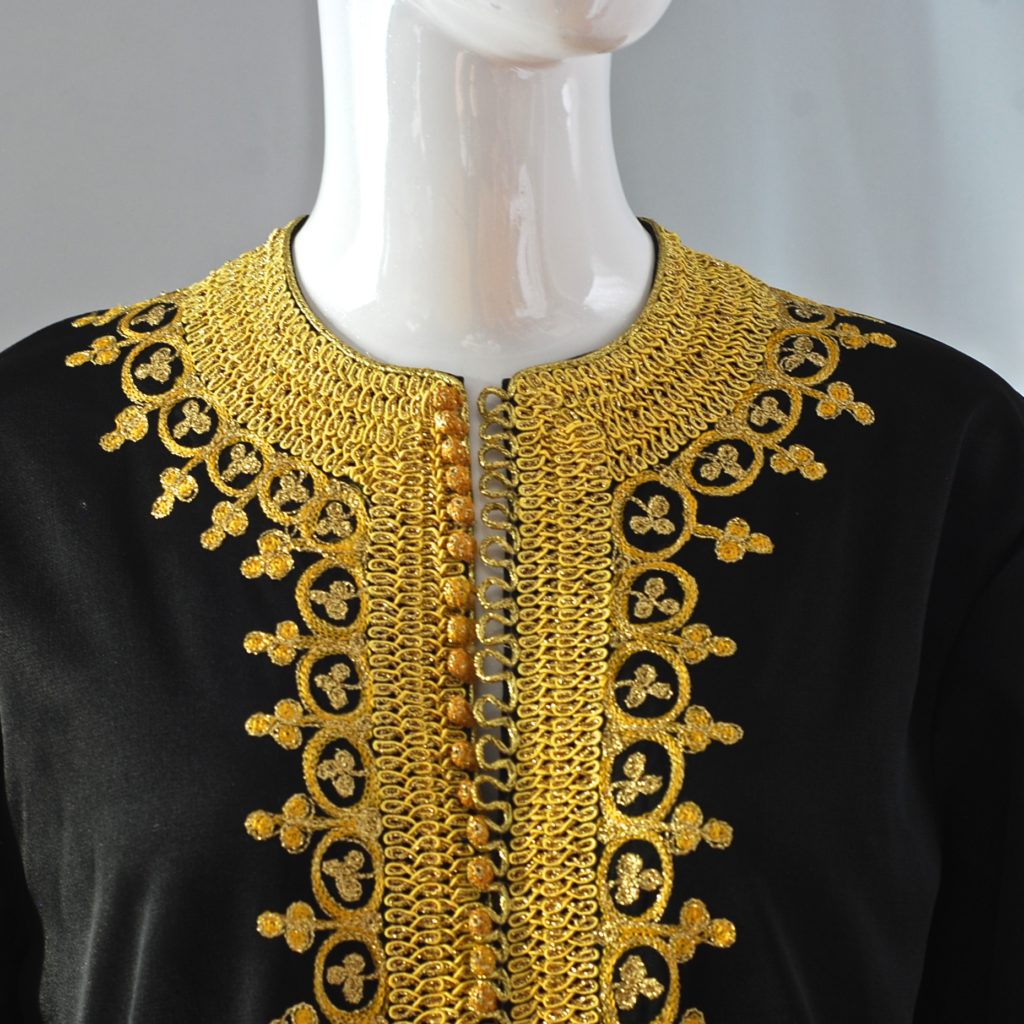





Reverse Side Of Embroidery
July 23, 2017
| Valerie Hayes
| Business & Web Development, Fashion Research, Feature Articles, View All Articles & Photos
As much as we can appreciate and learn from the expertise of others, beware of the collectors and sellers who claim to know it all. For those who are truly immersed in vintage textiles and design, it is a never-ending learning curve. When we seriously delve into the arts, like many other vast topics – it will increase our awareness of how little we know. A stubborn superiority will do nothing to alleviate our ignorance.
There are thousands of different types of fabric. Rayon alone has fifty different types and descriptions. The difference between hand loomed and machine loomed requires knowledge and a close examination of the garment. Fabrics such as mock crochet and many of the silk satin blends used in vintage clothing are now obsolete. Historical textiles from Egypt, India and Japan, for instance – can be traced back two or three thousand years. One could study textiles alone for an entire lifetime and still not know it all.
The same goes for jewelry. For example, there are thousands of sterling silver markings. I believe Mexico alone has around twenty-five hundred. Jewelry is fairly easy to transport and save – therefore it is more likely to survive the test of time. The country of origin in both textiles and jewelry design shines through in the product. Mexican sterling silver is artistically superb – especially the early and mid-century Taxco. Scandinavian and Navajo sterling silver has a very different and distinctive look compared to Mexican sterling silver. Gemstones in the jewelry also reflect the country of origin, such as the old turquoise mines, gemstones in the particular location, various treatments, settings, and alloys used.
One of the big questions in vintage clothing is in the perceived authentication of designer pieces. I don’t dispute that the vintage clothing market is complex, because it is and always has been in a state of flux and change. It is easiest to see this once you compare the same brand from decade to decade. Louis Feraud clothing from the sixties is highly desirable and recognizable. The eighties Louis Feraud is not as distinctive or as creative, however some of the scarves and certain pieces are drop dead gorgeous regardless of the age.
In my opinion the primary way to authenticate a designer garment is twofold – one is by the labels. The other is by the fabric and design. The best designer vintage has all labels to include the brand, fabric and where it was made. Pre-seventies clothing will often not have fabric content because it was not a legal requirement to have the fabric and care labels until then. Experience does help with evaluating the authenticity of a garment. However, if that information cannot be passed onto the consumer logically and without the pretense of knowing something they don’t know – how is that fair to the consumer or to the industry?
The art and history surrounding fashion design and textiles is as vast as any field can be. We are studiers and stewards of things that came before us – things we ourselves did not create. As human beings we are prone to making mistakes. There are hundreds of little tricks to help us identify things. If you use a jeweler’s loupe to examine fabric, it helps differentiate types of embroidery, the warp and weft of the fabric, loomed versus printed, damask versus brocade, etc. Gradually more and more criteria gets added to the list in your head when evaluating vintage garments. Anything that has covered buttons and/or silk lining warrants a second look.
A jeweler’s loupe will also help identify hand painted versus transfer decal, because you can see the dot pattern in anything that is printed. To determine if cinnabar is real, you hold the loupe at an angle and look for the layers in the lacquering. There is a very strong intuitive sense one gets from certain things. In some cases I will know immediately if the item is authentic – without looking at any labels. I do not buy anything designer with a Made in China label with the exception of vintage and antique Chinese silk embroidered pieces and Chinese export porcelain (and mud men). A small percentage of things in the collection are made in Hong Kong.
In many cases with jewelry I cannot identify markings that are worn or too faded. Another example is that designer labels like Dries van Noten were originally made in Belgium. Now many of the luxury labels are made in India. Dries van Noten also has clothing made in Romania on newer items. My philosophy is to be honest and up front about where an item was made and price accordingly. I do not consider famous brands to be authentic unless they are made in the country of origin. It may be a purist attitude but that’s how I see it.
In reality vintage designer clothing has become the crème de la crème of high fashion. Certain iconic pieces by Versace, Alexander McQueen, Thierry Mugler, Karl Lagerfeld, Rudy Gernreich, Christian Dior, Valentino, Courreges as just some examples – are now fetching prices between five and twenty-five thousand dollars per item. Some of the well-preserved dresses from the twenties are now listed on various sites for several thousand dollars each. I checked a textile auction in New York and saw that designer dresses with significant damage from the fifties and sixties sold for close to a thousand dollars each.
The clincher is that certain pieces by certain designers at specific times in their careers – are like original or limited edition art pieces. They represent the creative genius that drapes the human form – with rich colors, textiles, fluidity of movement and multi-dimensional ideas. The art in design has no room for know-it-alls. It is one big mirror room – both dazzling and dizzying in scope. A vintage clothing collection reflects the culture of a country. Online collections of vintage clothing from different locations are a unique representation of local talent as well as the migratory nature of things from faraway. I love to look at collections of vintage kimonos from Japan. The artistic elements of the Japanese kimonos surpass most textiles. A collection of vintage kaftans from Morocco would create an awesome and inspirational show.
We are all partakers of fashion to some degree. Some of us like to keep fanning the flames of fame for those with vision because they created beautiful things with lasting value. We pluck what we pluck for many reasons. I believe it is best to be dedicated to learning and willing to admit and correct mistakes. Why? Curiosity is a driving force. The field is sweeping and boundless. The biggest mistake is to get arrogant and convey to consumers that we know-it-all. It is completely acceptable to cite ones credentials – with specifics, not braggadocio hot air. We are more or less prone to filling in gaps with mere conjecture. I do accept and respect the knowledge of others, but it is not based on what they claim to be, more on what they are interested in and have experience with.
To create a division between “us and them” from those who declare to be experts – is the kind of limit the arts neither needs nor accepts. Just as in poetry, we get to pick and choose our words. That’s the beauty of art. Quite simply when it comes to vintage fashion and design – no one knows it all. The flow and finesse surrounding beauty and creativity in the arts contains a central hypothesis. Since it applies to almost all things requiring talent or knowledge – not only in the visual arts, but also in sports, literature, music, academia and technology. The bottom line is – show me your stuff. Don’t tell me how great you are. When it comes to vintage fashion – we are talking about material things. Besides all that – it is probably wise and a better reality check, to let those with less of a cognitive bias, be the ones to decide how great we are.
Copyright Valerie J. Hayes and Quiet West Vintage (2017). Unauthorised use and/or duplication of this material without express and written permission from this blog’s author/owner is strictly prohibited. Excerpts and links may be used, provided that full and clear credit is given to Valerie J. Hayes and Quiet West Vintage with appropriate and specific direction to the original content.
August 24, 2016
| Valerie Hayes
| Feature Articles, Textile Art, View All Articles & Photos
This hand woven silk damask textile by Raja is absolutely stunning. It is very large, with an ivory backdrop, rich in depth and texture, yet vibrantly reflective. The pictures below show each side of the design, as well as some close ups. Although there are many hand woven rugs from India and Pakistan, hand woven silks, and beautiful hand embellished saris – so far, I cannot find anything comparable to this on Ebay, 1stdibs, or any of the other sites on vintage textiles. From the Antique Textile History, the following information sheds some light on the origin of such a textile, not including the selection and preparation of the silk, or colours, but enough to enhance our appreciation:
“BROCADES – THE TRADITION OF BRINGING SILK TO LIFE
Brocade weaving, especially with gold and silver, has been an age-old tradition in India. There are two broad classes of brocades. Brocades of pure silk or silk and cotton blends and zari brocades with gold and silver threads. The most important material in brocade weaving is silk. It facilitates lovely weaves, is durable, strong, fine and smooth. There are several varieties of raw silk of which the chief ones used for brocades are Tanduri, Banaka and Mukta. Tanduri is imported from Malda and other places in Bengal. Banaka is thinner and finer variety and is mostly used to weave soft fabrics such as turbans and handkerchiefs. Mukta is a coarse and durable silk used for kimkhabs, as fine silk would not withstand heavy gold patterns.”
“MAKING NAKSHAS (DESIGNS) ON BROCADES
Making of nakshas (designs) forms an important part of brocade weaving. Banaras is the main center where the nakshabandha (designer) tradition prevails. The skill and imagination of nakshabandha plays a prominent part in making of designs. Designs are associated with legends and symbolism. The most popular motifs are drawn from nature. In Banaras, it is said that nakshabandha families were brought to this country during the reign of Muhammed Tughlak (1325-1350 A.D.). They were supreme masters of the art of tying designs into the loom. Local artisans and weavers learned this art from these great craftsmen. Some of these craftsmen were also great poets-perhaps they wove their poetry into their designs. One such renowned poet was Ghias-I-Naqsband, mentioned in Abul Fazl’s ‘Ain-I-Akbari’. The nakshas are first worked on paper. This part of the work is called likhai (writing). The nakshabandha then makes a little pattern of it in a framework of cotton threads like a graph. This pattern gives guidance to the working of that design into weaving.”
The example in this post, is a much heavier silk than most. The design on one side does not show through or impact on the other side. I am guessing it was part of a special ordered bridal trousseau, and estimate it to be from the sixties or seventies. It is truly extraordinary – with many components in the design and fabric, from dimensional rose floral outlines, to small raised slubs on the fabric, and a periwinkle contrast. The centre on one side features a large round design, a bouquet, outlined in coloured lines. In the very centre, there is a small red symbol or signature. The condition is pristine. It is one of the most beautiful textiles I have ever handled and photographed. It is visually tactile, a fascinating sight to behold, with a luminescent glow and vibrant colour and synchronization. It creates an exhibit with features unique to the richly exotic and historical textile artistry from faraway lands.
It demonstrates how the non-material world – beginning with the vision of a poet or artist, can be woven into the material world – and will always retain the beauty and vision of the soul that went into it. Initially as a concept it may seem overwhelming and elusive. Eventually it turns out to be, a fine representation – of soulful materialism and poetic realism.





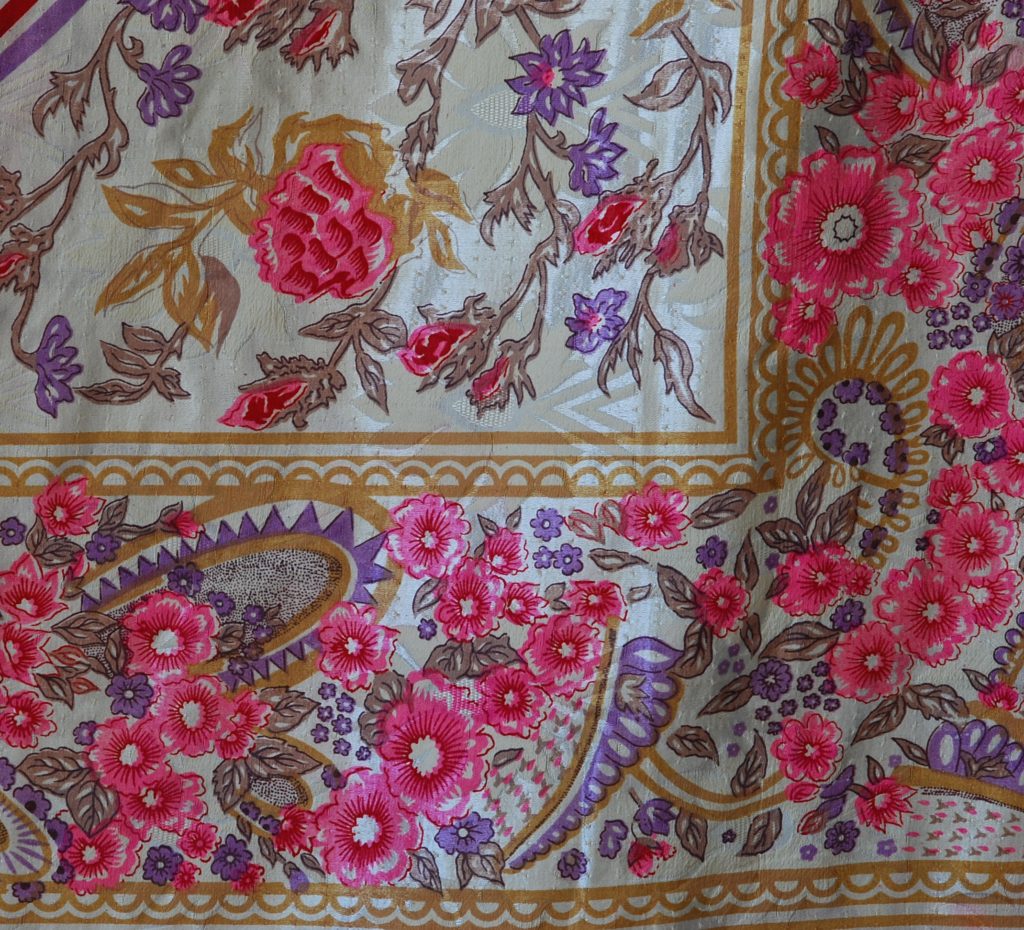


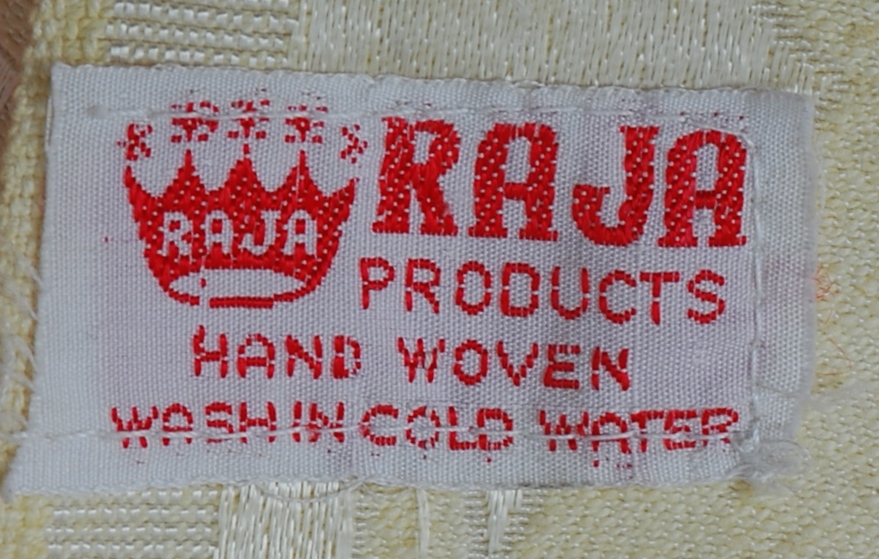
July 4, 2016
| Valerie Hayes
| Business & Web Development, Designer History, Fashion Research, Feature Articles, View All Articles & Photos, Vintage Outfits
To sum up the Canadian Designer Celebration mini series, a high percentage of Canada’s best mid-century designs and designers, have their roots in Montreal. The more I delve into the collection, and the labels – the more I realize how much of our great fashion history can be credited to Montreal. When it comes to fashion, the French do not disappoint. Toronto as a second runner-up, retains a mid-century vibrancy, with its legacy of notable designers.
The Montreal designed little black cocktail dresses from the sixties, are as sleek, and as wearable today, as they were back then. The hallmark of a great designer, is in the timelessness of their creations. I will happily share some exclusive examples…Starting with a late fifties, or early sixties Irving Nadler lace cocktail dress with a cape style top.


Irving Nadler, Montreal Late 1950’s or early 1960’s Cocktail Dress

 The next 1960’s little black dress from Montreal is aptly labeled – After dark Cocktails.
The next 1960’s little black dress from Montreal is aptly labeled – After dark Cocktails.

After dark Cocktails, Montreal 1960’s black halter dress.




Another Montreal classic little black dress, 1960’s black velvet, with gold piping at the waist. This one has the musical label – Beau Time Melodie Frocks.



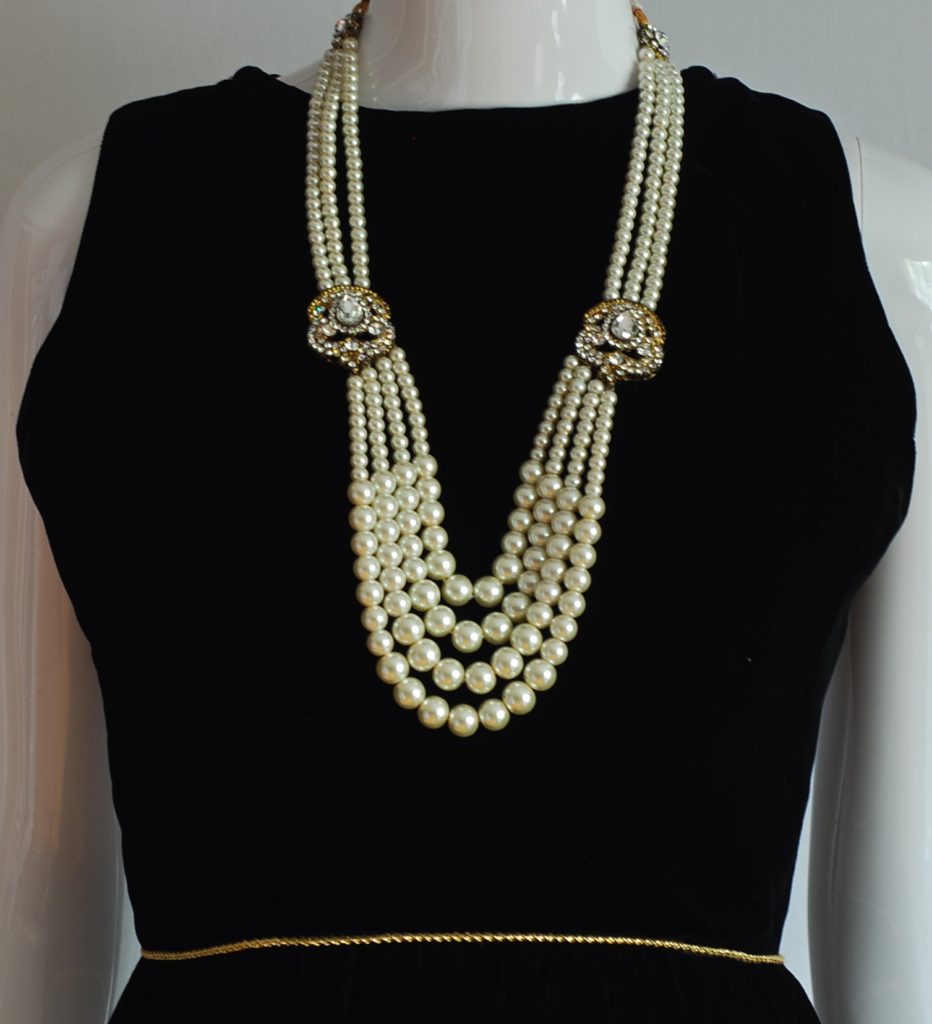
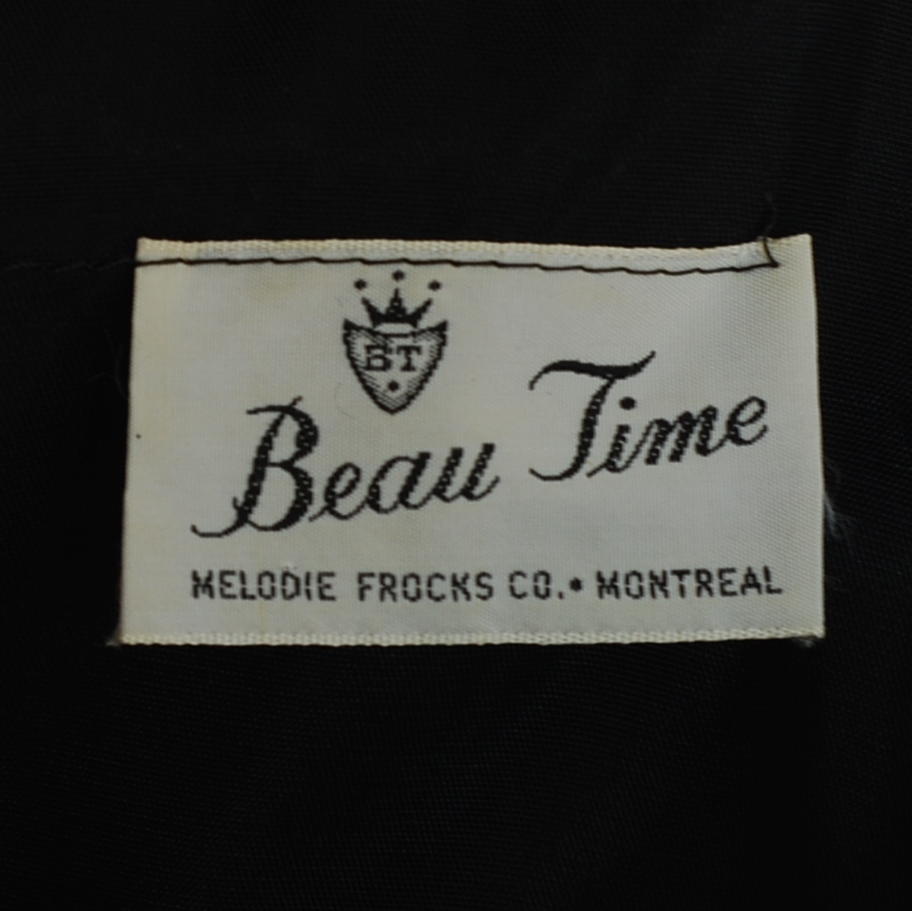
An impressive 1950’s full circle skirt by Montreal designer Val Hughes.



To end the series on a brighter note, this very artistic, abstract printed silk skirt, is labelled Cocktail Montreal. Thanks to these fabulous and talented designers of the eras – they put Canada on the runway, when it comes to mid-century chic.


July 4, 2016
| Valerie Hayes
| Business & Web Development, Designer History, Fashion Research, Feature Articles, View All Articles & Photos, Vintage Hats
These wonderful hat designs are mid-century Canadian, made in Montreal and Toronto:
Lilliput, Toronto feathered fedora with velvet accents.

Lilliput Feathered Vintage Fedora – Toronto, Canada


Featuring Nadelle, Montreal 1960’s velvet lampshade hat, and Nadelle 1960’s elaborate beaded turban.



 Leopold Original, Toronto 1960’s Velvet Hat With Big Satin Bow.
Leopold Original, Toronto 1960’s Velvet Hat With Big Satin Bow.
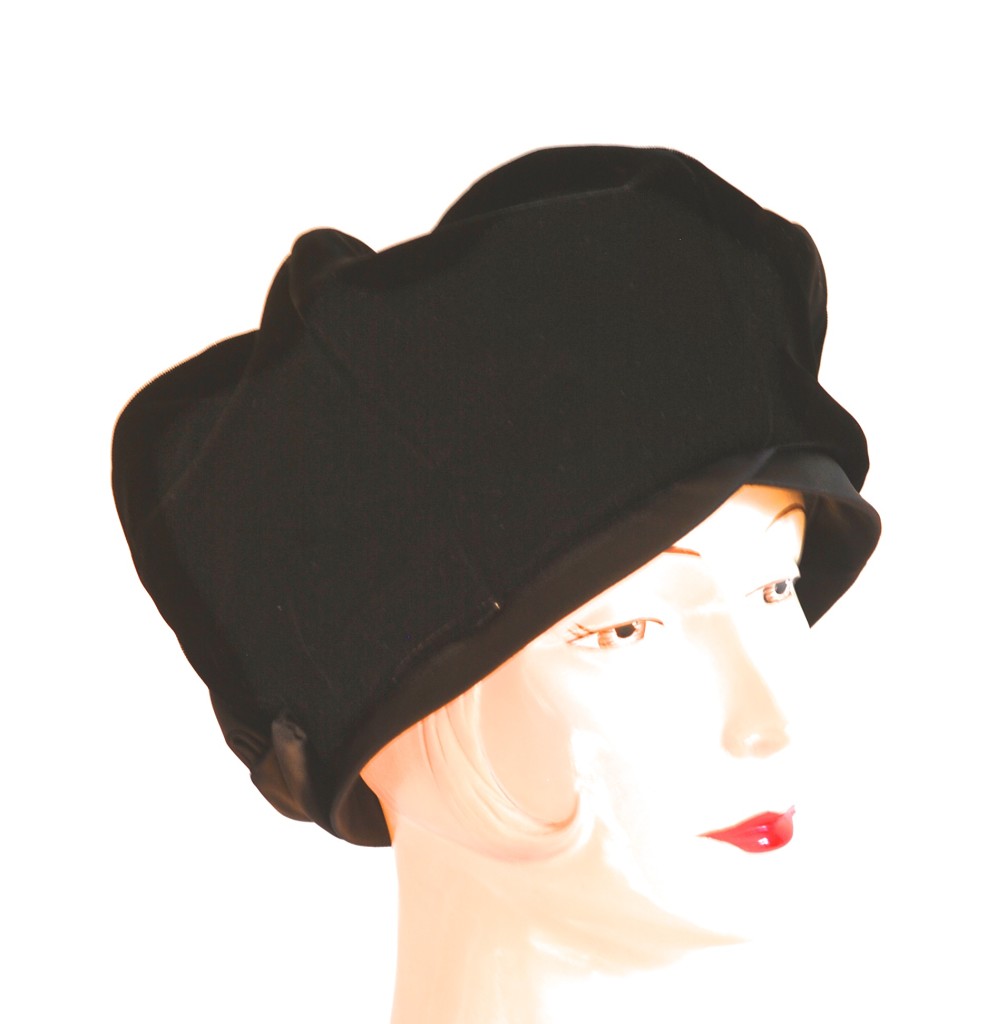
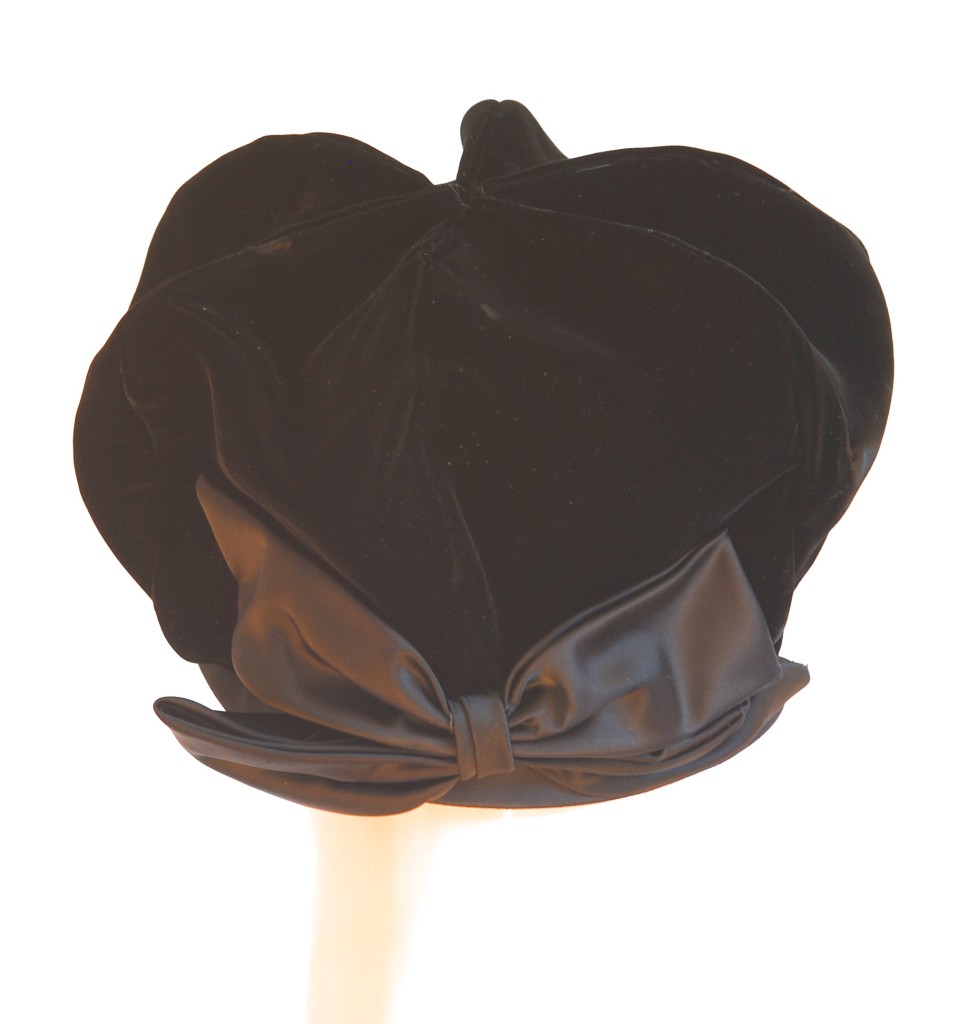 Andre, Montreal 1960’s Gold Brocade Turban.
Andre, Montreal 1960’s Gold Brocade Turban.

 M’Sieu Leon, Montreal 1970’s Beaver Fedora.
M’Sieu Leon, Montreal 1970’s Beaver Fedora.


July 3, 2016
| Valerie Hayes
| Business & Web Development, Designer History, Fashion Research, Feature Articles, View All Articles & Photos, Vintage Outfits
This exceptional 1980’s Wayne Clark Couture dress, is made of layered silk chiffon, with rhinestone embellished lace inserts in the bodice, and sheer balloon sleeves. The dress has rows of satin piping down the length of the skirt, satin cuffs, and matching trim on the bottom layers, of an asymmetrical hemline. The back is open, plunging to the waist, and ties at the back of the neck, with a dangling satin ribbon.
For those who love the floating and fluid movement of a silk chiffon skirt, and being well covered; in a pose to behold. Those watching your back, will know… A Wayne Clark dress – is worth its weight in the folds!
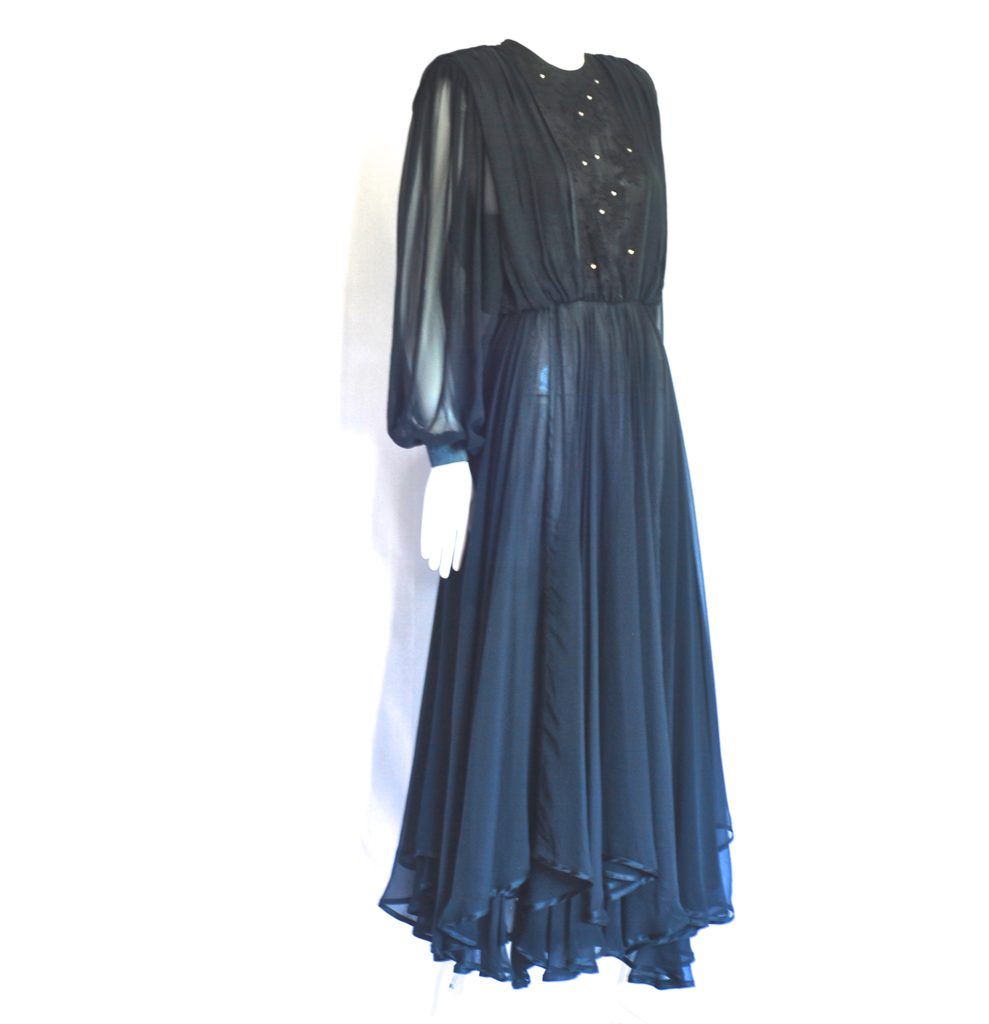
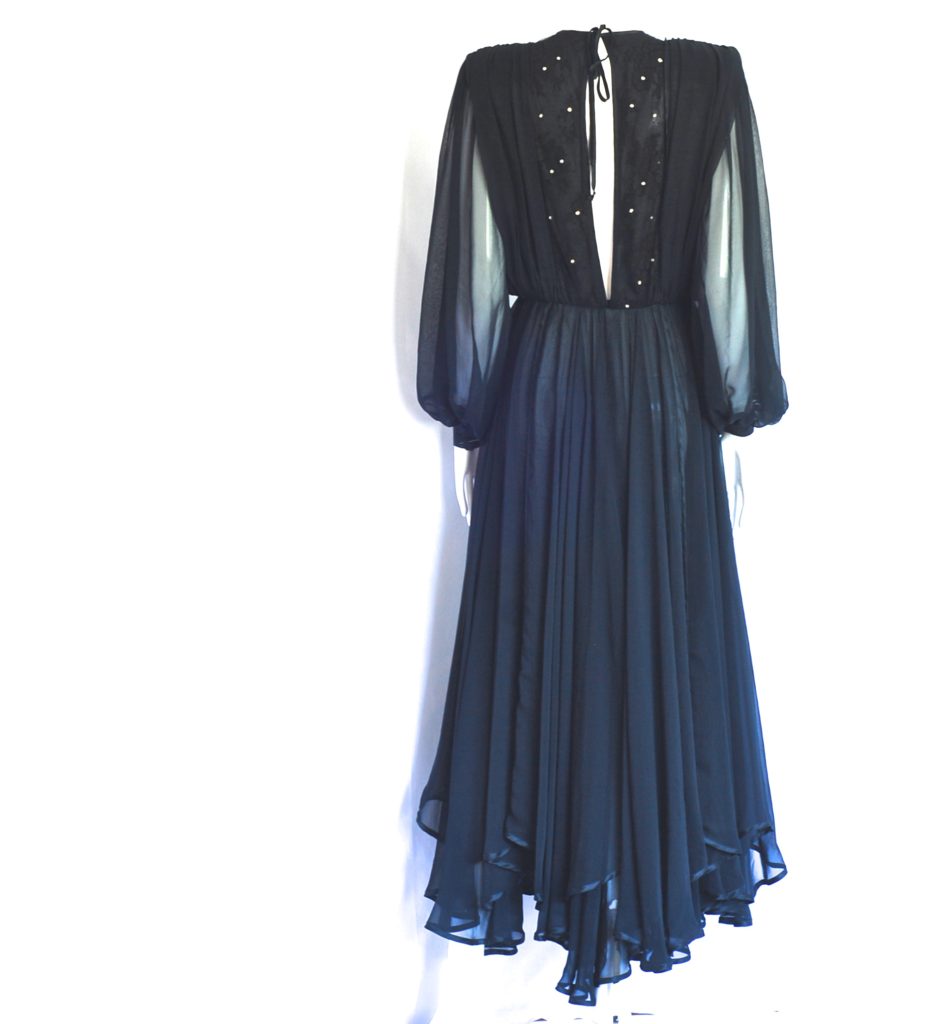



July 3, 2016
| Valerie Hayes
| Business & Web Development, Designer History, Fashion Research, Feature Articles, View All Articles & Photos, Vintage Jewelry
Gustave Sherman of Montreal made costume jewellery from 1947-1981. The company logo was “made to last a lifetime”. He sourced out, and used the highest quality Swarovski crystals, and set very high production standards. The backing on Sherman jewellery is heavily rhodium plated, japanned, or sterling. The stones are brilliant, cut with precision, into narrow marquise stones, with cluster elements, and stunning designs. Sherman jewellery lasts to this day, and will last much longer, therefore the jewellery was made to last more than one lifetime.
Sherman jewellery has always been recognized as high end costume jewellery, and was sold through luxury retailers and jewellery stores. The jewellery continues to be highly collectible. Certain pieces, in particular full sets, and the colour Siam red, command high prices, and have set off bidding wars on Ebay. Gustave Sherman passed away in 1984. His legacy, and commitment to the highest standards in craftsmanship, has left us with sparkle and shine – to wear and to admire, for many years to come. From the Quiet West collection, the following are some fine examples of the lasting quality in Sherman jewellery.
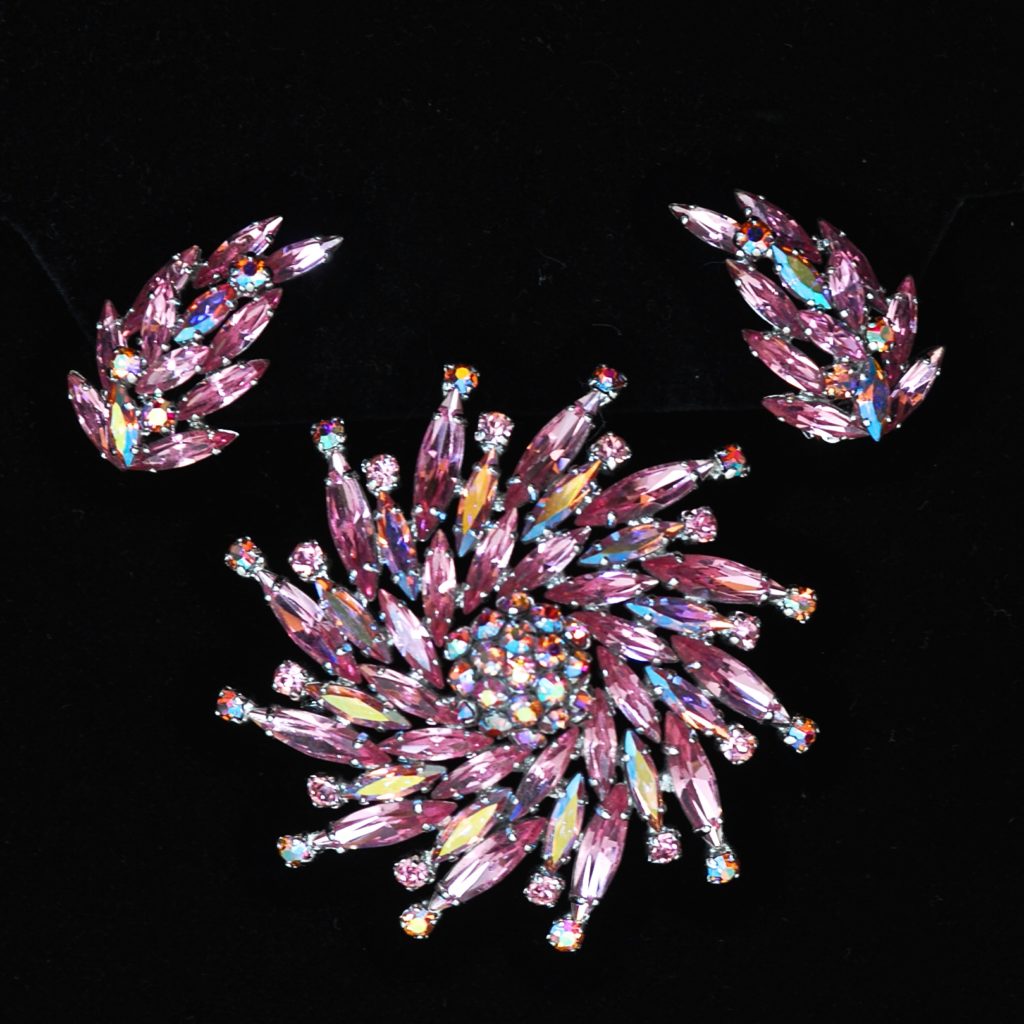
Sherman Pink Earrings & Matching Pin
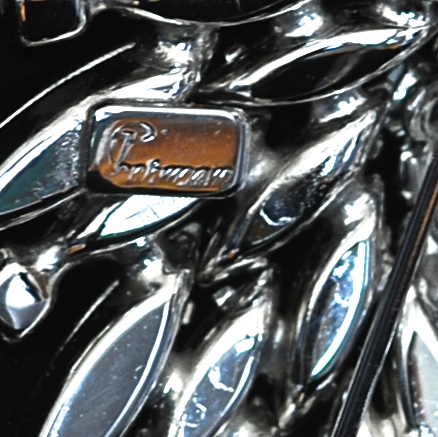
Sherman Script Signature

Sherman Earrings With Blue Marquise Cut Stones
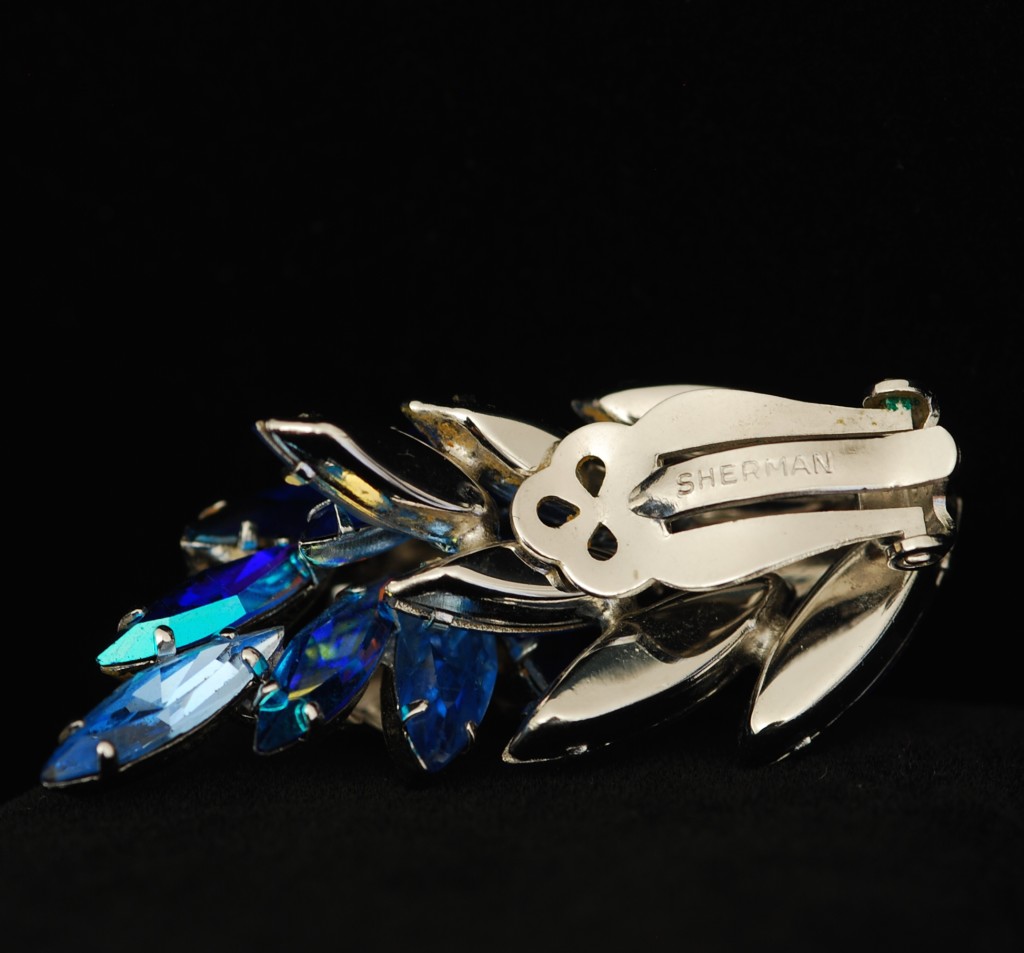
Sherman Signature in Block Letters
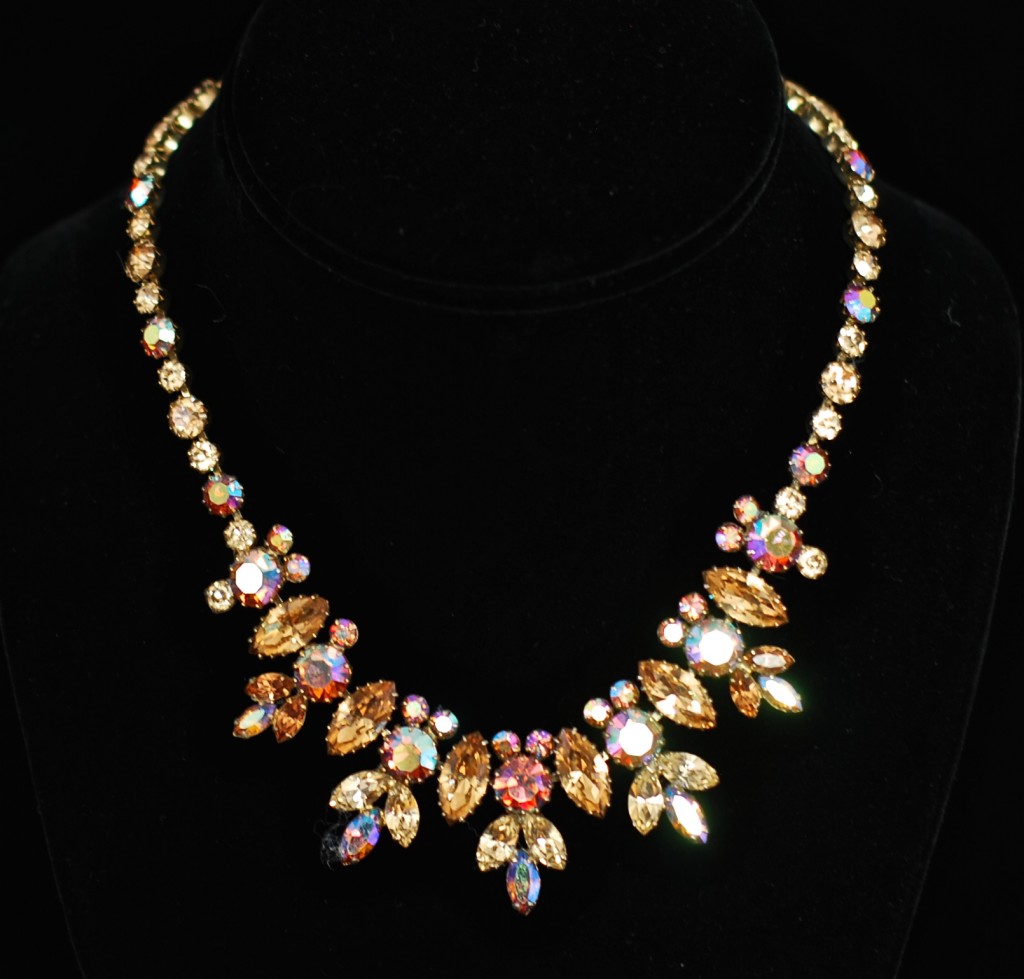
Gustave Sherman Stunning Vintage Necklace

Sherman Signature On Necklace

Sherman Bracelet With Coloured Stones

Sherman Bracelet With Safety Chain On Clasp
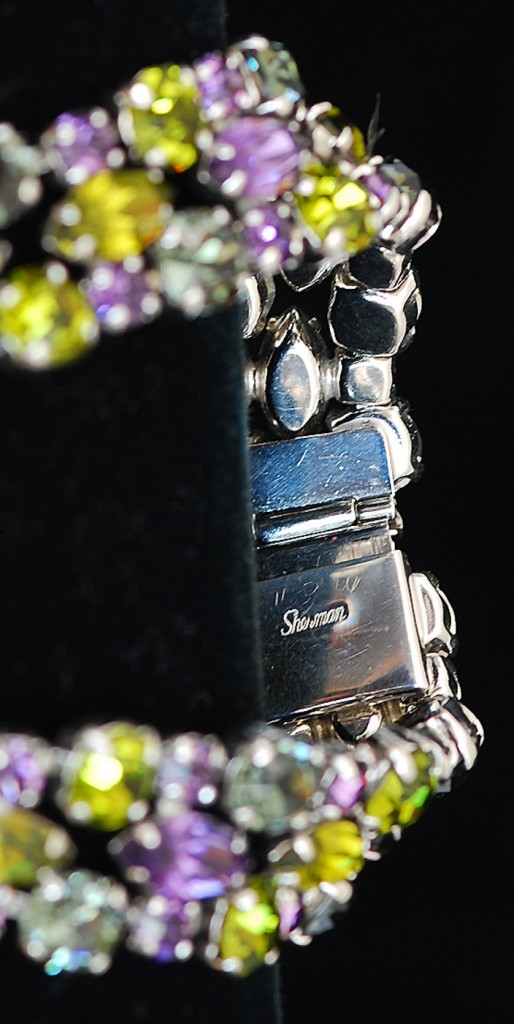
Sherman Signature On Coloured Bracelet



Sherman Fabulous Large Rhinestone Pin

Gustave Sherman Blue Crystal Pin
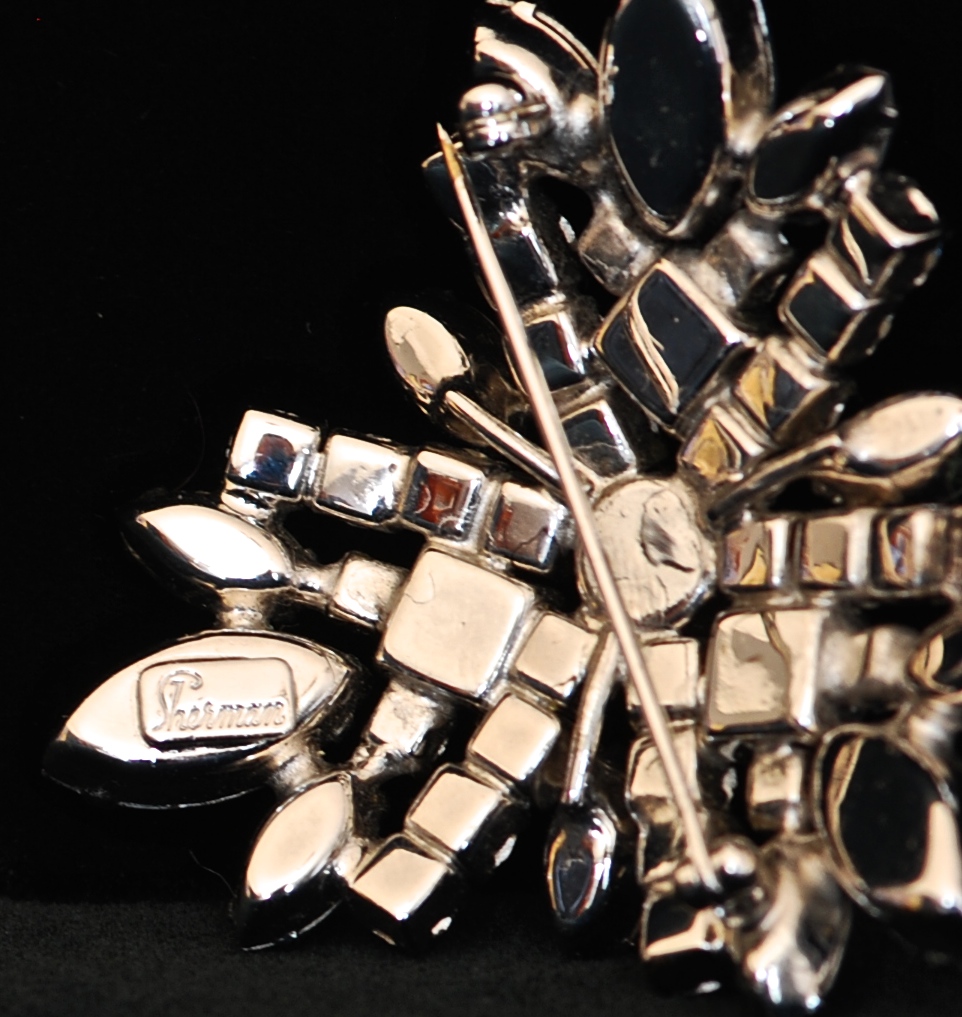
July 2, 2016
| Valerie Hayes
| Business & Web Development, Designer History, Fashion Research, Feature Articles, View All Articles & Photos, Vintage Outfits
Claire Haddad: Born July 17, 1924 – May 17, 2016. Her bio states she is “an Order of Canada recipient, and fashion designer to the stars”. One of her dresses was on the front cover of Vogue magazine in April 1966, worn by model Veruschka von Lendorff, and photographed by Rubartelli.
Based out of Toronto she was known for creating eclectic lounge wear, and luxurious high fashion sleepwear from the early sixties until the eighties. She was forward thinking enough to envision loungewear, worn as elegant evening attire outside the home.
From the Quiet West collection – it is a pleasure to share a fabulous 1960’s Claire Haddad kaftan featuring a desert scene on a vivd background of electrifying colours, which was so hip in the sixties. The trim is black, loopy cord, and outlines the neckline downward to the V opening on the front. The trim changes into looped cord buttonholes, for small, rounded black buttons. The two front slits and sleeves are also accented with matching trim. The overall portrayal is so sixties trippy – of swaying, shocking pink palm trees – and camels heading into a psychedelic oasis. It really is brilliant!

Claire Haddad 1960’s Kaftan


August 24, 2014
| Valerie Hayes
| Fashion Research, Feature Articles, View All Articles & Photos
If we look at an overview of fashion history over the past two hundred years – it is quite revealing. The pendulum did swing. It seems that the two world wars had the greatest influence on women’s fashion, which led to the fashion revolutions of the twenties and again in the sixties. When the men went to war, women had to take care of the farms, children, businesses – and in many cases, do the work of a man. It changed things. There was a period of liberation and newfound confidence that developed. Women did not have to be put on display in corsets and hoops. In danced the flapper era, bobbed hair and the Charleston.
The Charleston is a dance that became popular in 1923, when it was featured in the Broadway show called “Runnin’ Wild”. It became a dance craze associated with flappers, prohibition and the term speakeasy. The term speakeasy caught on when a newspaper described saloons and taverns as speak-easies. During prohibition there were many places that sold alcohol. They were raided frequently, but were so profitable – it made no difference. In fact there was a marked increase in organized crime associated with prohibition. In addition to the term speakeasy, the taverns were also referred to as Big ol Ben, Big Toad, Blind Pig or Blind Tiger. The viewing of the animal was argued to be the main attraction. The owner of the establishment would place an animal on display. The patrons would get served alcoholic beverages after they paid to see the animal. They drank and danced the Charleston – frequently with women dancing while the men watched. It is most interesting to know that a song that was written and composed for a Broadway Musical ended up having such far-reaching societal impact with a strong political message. People just refused to have no fun. And although that is a double negative – it turned out okay.
The Second World War was rife with so much propaganda and grief – it took years for the next wave of rebellion to percolate. When it did – the skirts got shorter and some went on acid Kool-Aid trips. There was a generation gap like never before. LSD was a popular drug during the sixties. A Swiss chemist discovered it in 1949. Once they became aware of the psychoactive properties, it went to big Pharma and was marketed by the drug company Sandoz. The drug was widely used recreationally as well as in medical research. The stories of the use of LSD in psychiatry, oftentimes on unsuspecting patients, so their reaction could be studied – was appalling. It was not until there was public outcry over bad trips, suicides and flashbacks associated with the drug, that they stopped using it. Sandoz stopped production in 1963 – however, it was used in medical research up until 1980. The drug was made illegal as a recreational drug in the late sixties.
The sensational death of Diane Linkletter (TV personality Art Linkletter’s daughter) in 1969 became widely publicized, when she supposedly jumped to her death from a sixth story window when high on LSD. This event became the catalyst for beginning the war on drugs. But, in digging a little deeper into the death of Diane Linkletter, I learned that she was not alone in the apartment. The toxicology showed that she did not have any drugs in her system. Many years later, her boyfriend who was with her at the time, was involved in another suspicious death involving a female celebrity. At the very least, it could be said, that Diane Linkletter’s death is a mystery. And the war on drugs was a pointless hoax.
Marijuana does not have the colored past that is associated with alcohol and LSD as far as drama and tragedy is concerned. It was made illegal long before the more potent drugs like LSD. In 1923 it was somehow placed under the Opium Act, yet it is clearly not an opiate. If you ingested a half a pound of it, it would not show up in toxicology studies as an opiate. Nor would it give the same symptoms of overdose as opiates. As we all know, there is a long history associated with attempts to have marijuana legalized. And similar to prohibition – no matter how many raids crop up – it is still profitable. The thing that seems odd to me is that marijuana is not a narcotic, therefore, how can it be classified as one? It would seem that all drugs, regardless of what they are used for, should be classified with some accuracy, and not lumped together with drugs that have completely different properties. After all, drug properties are supposed to be science.
Fashion and creative freedom stem from a certain level of rebellion. I would term it as a peaceful rebellion, since fashion statements do not usually harm anyone (with the exception of six inch heels!) Fashion – like music, poetry, writing, painting, gardening, and interior design – is all about self-expression. Oppression, contradictions, control, and hypocrisy all force change. The greater the effort to control, the more people will find a way to define themselves. Every individual is unique. We hope not to be changed by the rippling effects of conflict and war. We hope not to be robbed of our identity in any way. To allow others to define us is a mistake and waste of potential. From a purely practical perspective, not all styles and trends suit all body types. We can look back into the political context of the different eras that gave rise to the hemlines. Those individual statements contributed to a movement.
The distinction to be made about Runnin’ Wild – is that it was not so much about being bad, as it was an expression of freedom. After all, if you look at either the flapper style or the Charleston, they are hardly sinister. Even the flapper’s response to prohibition was not all that bad. They actually made a point…when they kicked up their heels.
Copyright Valerie J. Hayes and Quiet West Vintage (2014). Unauthorised use and/or duplication of this material without express and written permission from this blog’s author/owner is strictly prohibited. Excerpts and links may be used, provided that full and clear credit is given to Valerie J. Hayes and Quiet West Vintage with appropriate and specific direction to the original content.
August 23, 2014
| Valerie Hayes
| Business & Web Development, Feature Articles, Thoughts & Ideas, View All Articles & Photos
The word tautology has a nice ambiguous ring to it. It originated with the ancient Greeks who soon saw it as the mere repetition of words to support an argument. The logic behind it, a concept which later cropped up in propositional mathematics – is that if you reword and say the same thing over and over, each statement will fill the contingent of logic, support the argument and make it true. There is a formula.
In the forties and fifties Rudolf Flesch contributed to the recognition of tautologies in the written word. He wrote titles like “The Art of Clear Thinking” with a chapter title “How Not To Be Bamboozled”. He also wrote “The Art of Plain Talk”. Gotta love this guy!
But isn’t repetition with a few variables thrown in, the only way to reinforce something? Tautologies are getting tighter. It is the contraction of the sheer volume that must now be sifted. The information age is causing them to shrink – like wool in a hot washer. If you take out all superfluous words and repetitions – it strips the wordy embellishments to reveal the core. Padded writing is sort of like a glitzy, tacky overdone outfit.
Now, we have SEO’s and key words. We have a skeleton of tautologies in every realm. We just have to remember – that repetition – doesn’t necessarily mean that something is true or authentic. Authenticity has a solid ring to it. It holds onto some class. Maybe stripping away all superfluous and repetitious words brings us closer to poetry…since poetry says as much as possible with as few words as can be gotten away with. Therefore the core concept often has an elemental truth.
It might be on the horizon to drum up SEO’s out of a poem or a song…and like birds in the forest – the white noise is lost, leaving only the voice.
Copyright Valerie J. Hayes and Quiet West Vintage (2014). Unauthorised use and/or duplication of this material without express and written permission from this blog’s author/owner is strictly prohibited. Excerpts and links may be used, provided that full and clear credit is given to Valerie J. Hayes and Quiet West Vintage with appropriate and specific direction to the original content.
August 23, 2014
| Valerie Hayes
| Business & Web Development, Feature Articles, Inside Passage Legendary Map, My Story, Poetry By Valerie Hayes, Thoughts & Ideas, View All Articles & Photos, Vintage Hats

Inside Passage Legendary Map By Quiet West Publishing
Ladies Wear Many Hats
Ladies wear many hats ~
We put the lady on the map,
To illuminate despair –
To journey where we dare;
To follow rivers to wilderness,
To fly and then return to nest.
To soften contours of the stone –
And pave the road with poems.
Valerie J. Hayes

Early 1900’s with Real Bird. This Practice was Banned in 1909
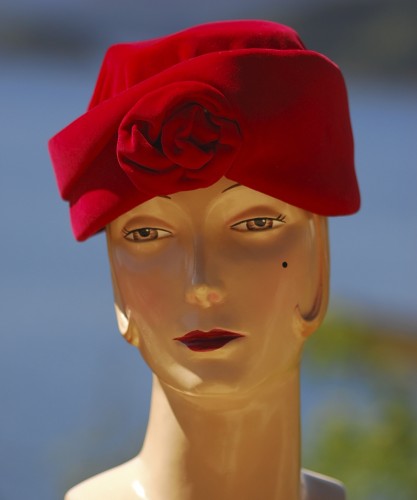
1960’s Velvet Rose Hat

1940’s White on Black

1950’s Scarlet Glamour

Carved Mother Of Pearl In Natural Sun Lit Colours
Copyright Valerie J. Hayes and Quiet West Vintage (2014). Unauthorised use and/or duplication of this material without express and written permission from this blog’s author/owner is strictly prohibited. Excerpts and links may be used, provided that full and clear credit is given to Valerie J. Hayes and Quiet West Vintage with appropriate and specific direction to the original content.
January 23, 2014
| Valerie Hayes
| Business & Web Development, Designer History, Fashion Research, Feature Articles, View All Articles & Photos, Vintage Hats
When I first started collecting vintage hats, it was enthralling to see all the different designs and colors. Hats from the thirties, forties and fifties were still fairly abundant in the late seventies and early eighties. It was considered “off the wall” to collect them. The general belief was that they would never be worn again. In fact, the key designers have retired or passed away, and many of the styles have never been made again. One thing remains true. Many people wear hats well. There are some gorgeous hats that have survived the test of time and chance.

1960’s Straw Cloche by Designer Schiaparelli

Schiaparelli Paris Label

1950’s Gold Beaded Beanie
How could they not fascinate us? A hat changes a person’s aura and creates a heady fashion statement that rivals no other part of the attire. During the 19th and 20th century, every design that could be conceived of was shaped into a hat. One of my favourite photographs is of a 1930’s hat that was listed in the Doyle Gallery in New York several years ago. It looked like a bees nest with bees buzzing all around it. There is a comic and whimsical element to a percentage of designs. Just as the hemlines went up after the war, the hats too, became either more utilitarian or more glamorous. The early 1900’s hats were still mostly wide-brimmed and decorated with flowers, berries, ribbons and even birds. The practice of taxidermy to place birds on hats was banned around 1909. Later on, in the forties – there was a bird revival. They used real feathers and made the body of the bird out of something else.
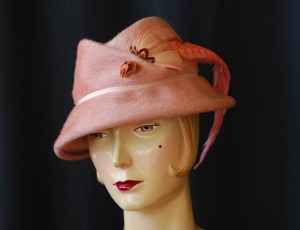
1940’s Bird Revival
During the eighties, when I collected hats that were mostly dated from the 20’s through to the 60’s – it was because those were the hats that were available and fairly abundant. I did not pay much attention to labels, but studied each hat and bought what I liked. Inadvertently, I did end up with some well known designer labels. Elsa Schiaparelli, Lilly Dache, Macy’s, Stetson Fifth Avenue, Christian Dior, Mollie Entwistle, and Jerry Yates – are some of the designers who made vintage hats to marvel at. There are many other more obscure designers who made hats to the same level of quality as the luxury designers. All were affected by the Second World War, which caused some to flourish and others to fail.
When looking for vintage hats now, I look first for a label. If it is made in China, it is not vintage, even though it may be a vintage style. A label for a quality vintage hat will be fairly large (usually) and will be made of fabric that is stitched into place inside on the back of the hat. Some of the labels have a small flower attached on the side of the label. If there is no label and you believe it is vintage, check the brim, inside the crown, to see if there is heavy grosgrain ribbon. Also, if the hat has any embellishments, evaluate what they are made of, since certain types of fabrics, ribbons, flowers, etc. were used that are not modern day. Sometimes the maker and country of origin is printed inside on the crown of the hat.

Mollie Entwistle Vintage Hat Label

1920’s Stetson Fifth Avenue
Before I acquired some Stetson Fifth Avenue hats, for some reason I thought Stetson was associated only with cowboy hats. But, Stetson Fifth Avenue made some interesting and upscale hats of different styles. A large percentage of fall and winter vintage hats are made of doeskin felt. Some are made of sealskin, which is often dyed.

1940’s Stetson Fifth Avenue
In the seventies, hats from the turn of the century were not available to the average person, unless you were a dealer, collector or museum. Hats from the thirties and forties seldom turn up in thrift stores anymore. The hats with face veils often get torn due to the fragility of the veils. Rubber bathing caps – unfortunately, there are only a few that have lasted – since rubber sticks together and disintegrates over time.

1950’s Rubber Swim Cap
Most hats can be brushed with a soft bristle natural brush in the direction of the grain and steamed into shape. Unless they are for display, it is best to keep them in a box with some acid free tissue paper. Face veils, rubber bathing caps and feathers require extra attention. Be very careful when steaming hats with feathers and avoid it altogether if the feathers have been glued onto the hat.
Copyright Valerie J. Hayes and Quiet West Vintage (2014). Unauthorised use and/or duplication of this material without express and written permission from this blog’s author/owner is strictly prohibited. Excerpts and links may be used, provided that full and clear credit is given to Valerie J. Hayes and Quiet West Vintage with appropriate and specific direction to the original content.























 The next 1960’s little black dress from Montreal is aptly labeled – After dark Cocktails.
The next 1960’s little black dress from Montreal is aptly labeled – After dark Cocktails.




















 Leopold Original, Toronto 1960’s Velvet Hat With Big Satin Bow.
Leopold Original, Toronto 1960’s Velvet Hat With Big Satin Bow.
 Andre, Montreal 1960’s Gold Brocade Turban.
Andre, Montreal 1960’s Gold Brocade Turban.
 M’Sieu Leon, Montreal 1970’s Beaver Fedora.
M’Sieu Leon, Montreal 1970’s Beaver Fedora.




































